This pattern shows you how to crochet a cheeky Amigurumi Crochet Reindeer named Rudi. Rudi loves to sled through the winter forest and already has a bright red nose due to Christmas anticipation.
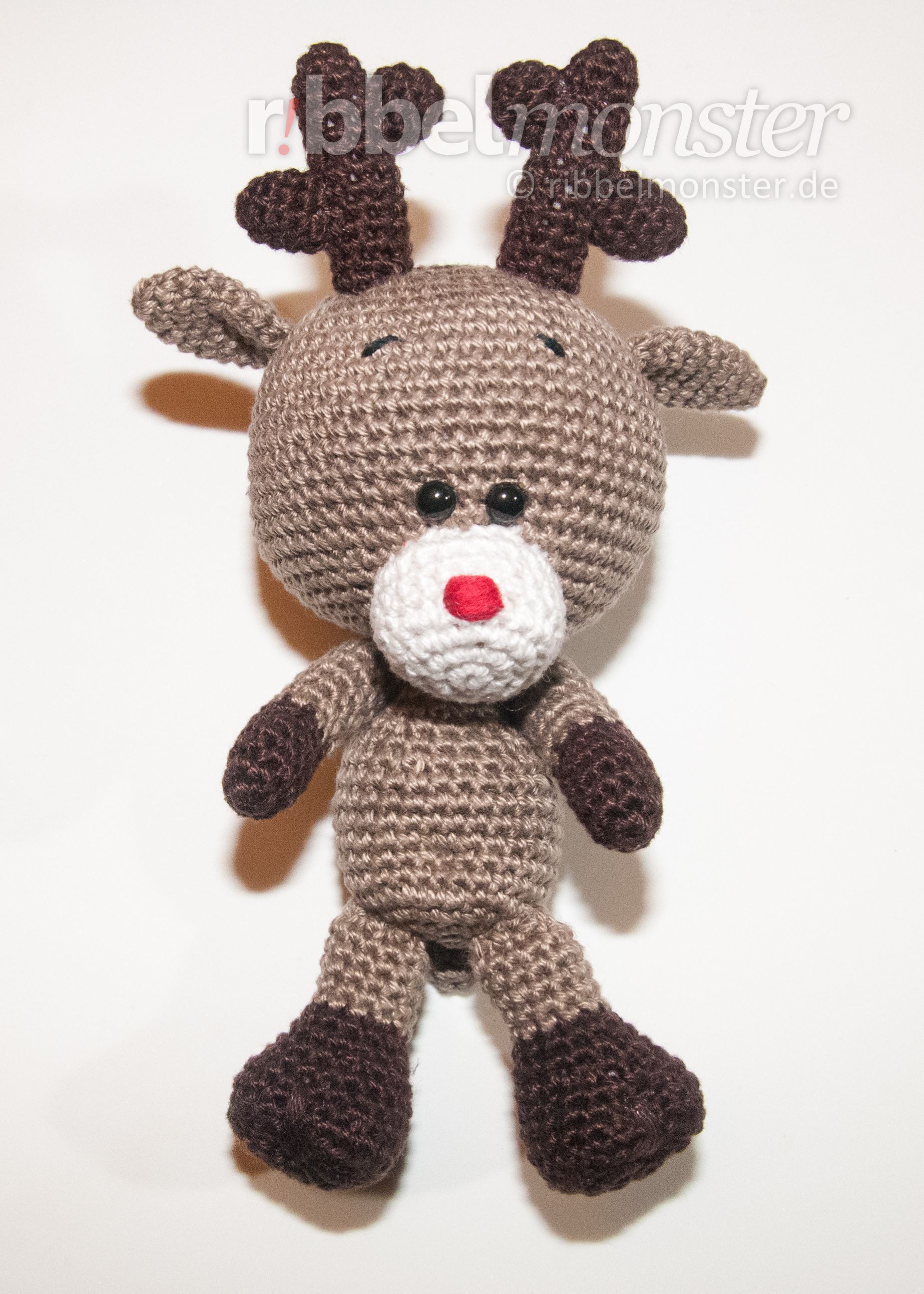
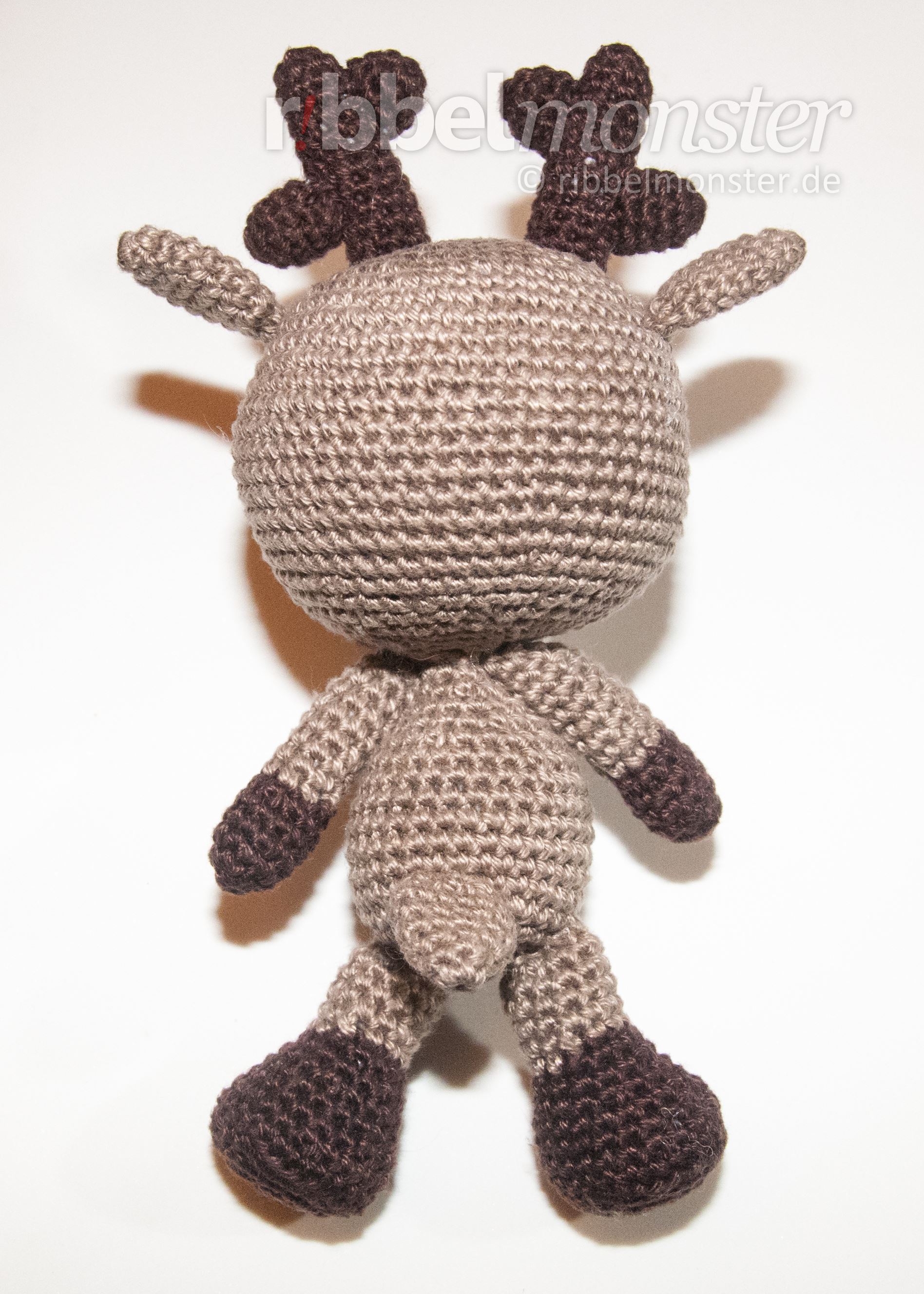
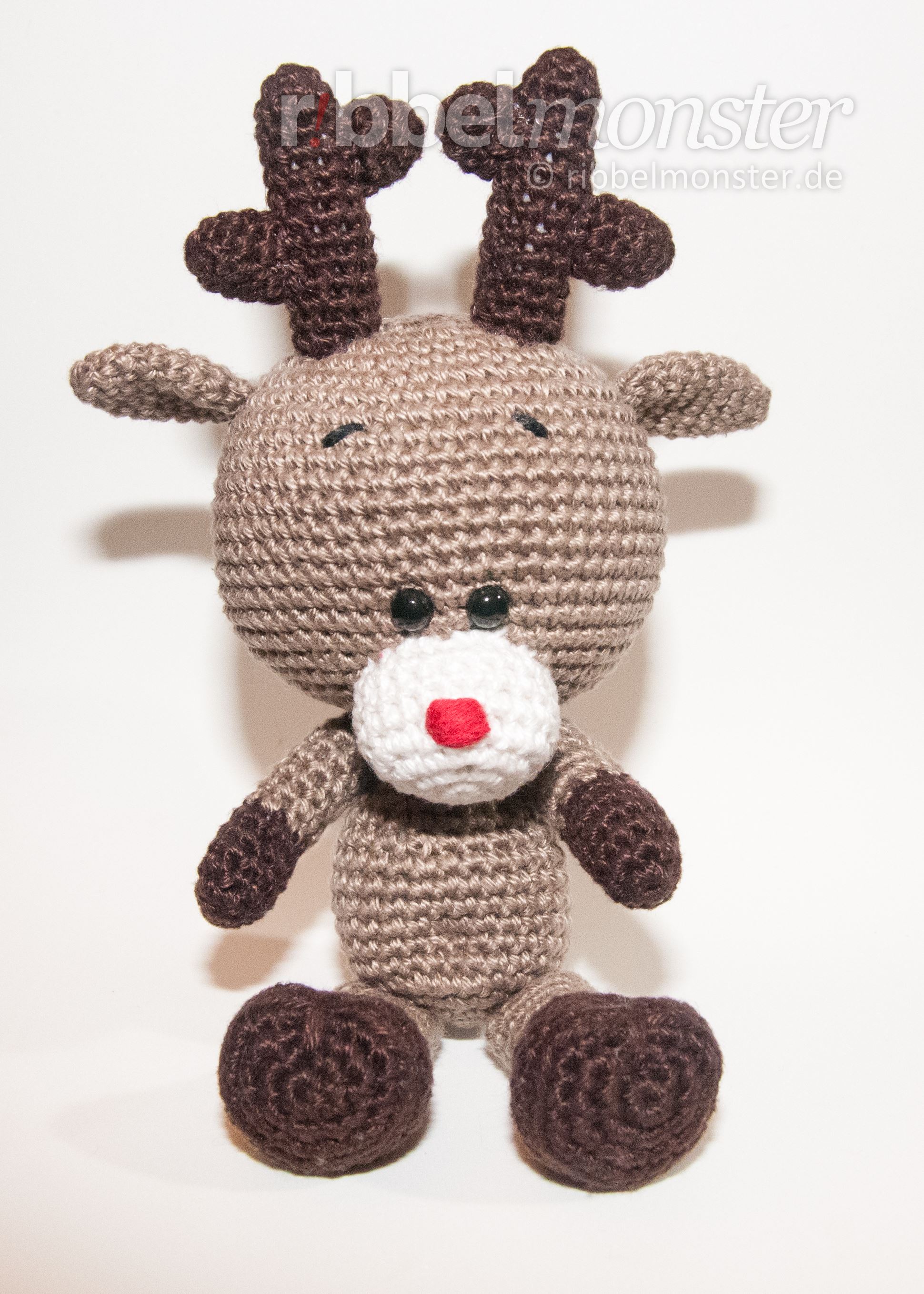
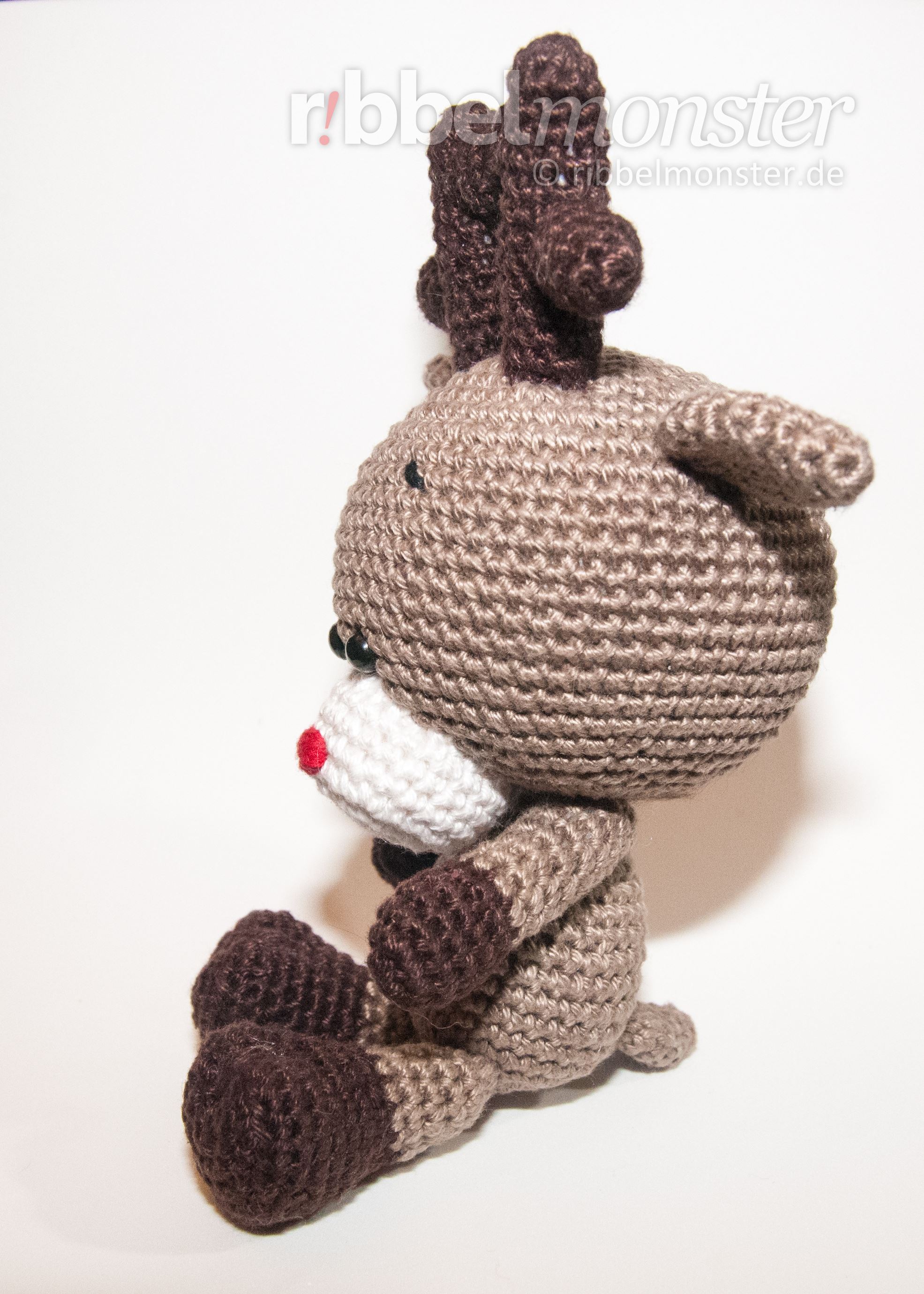
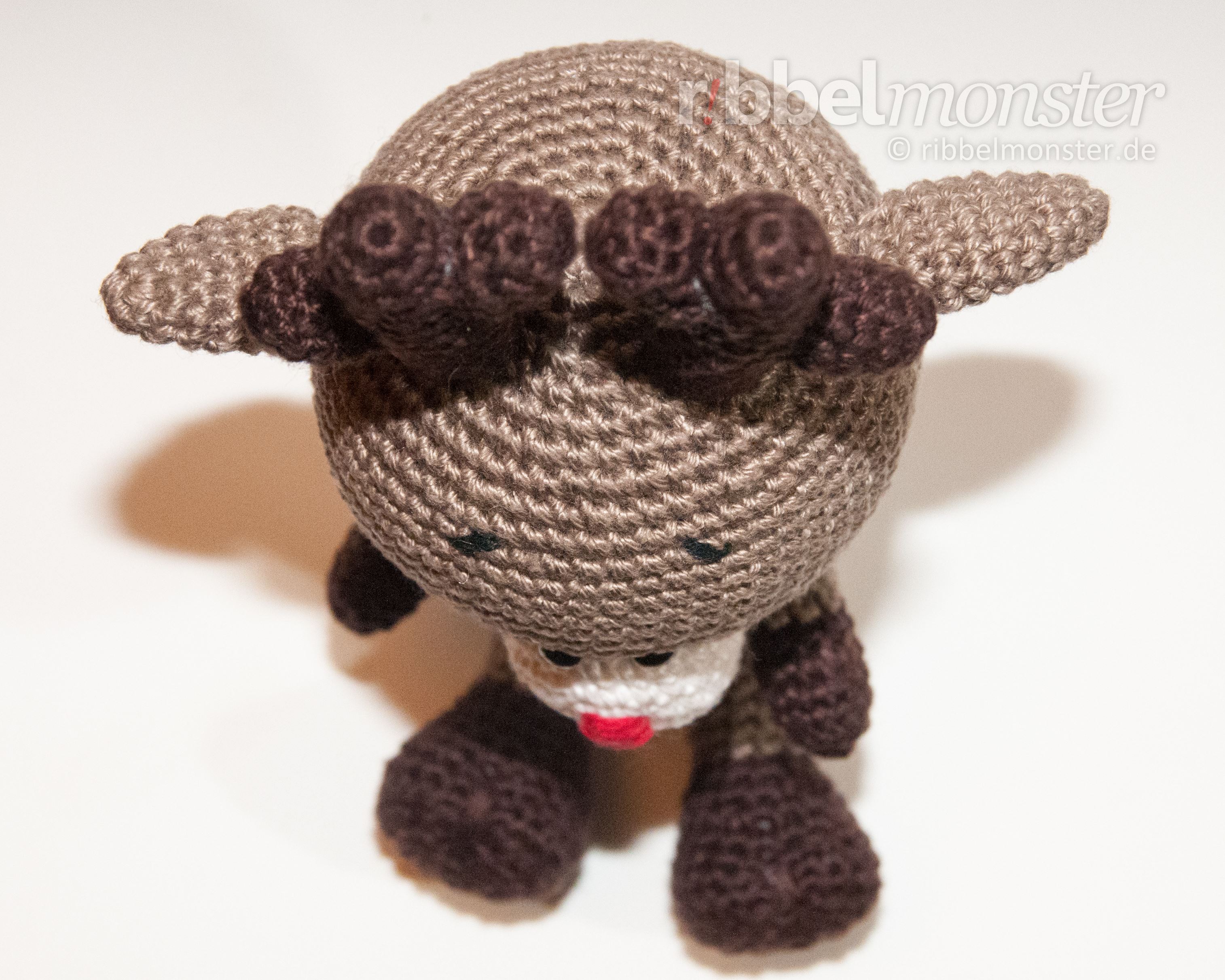
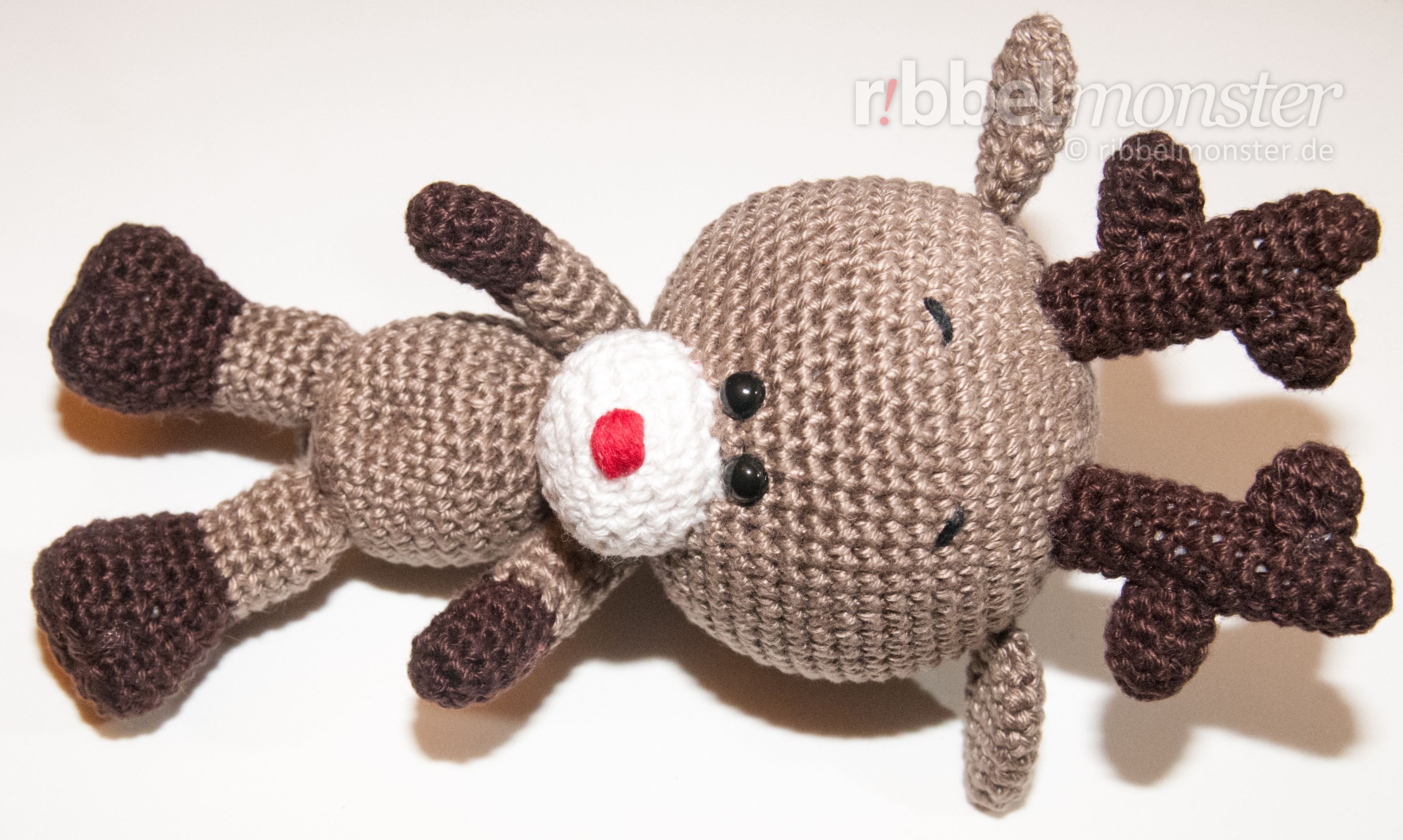
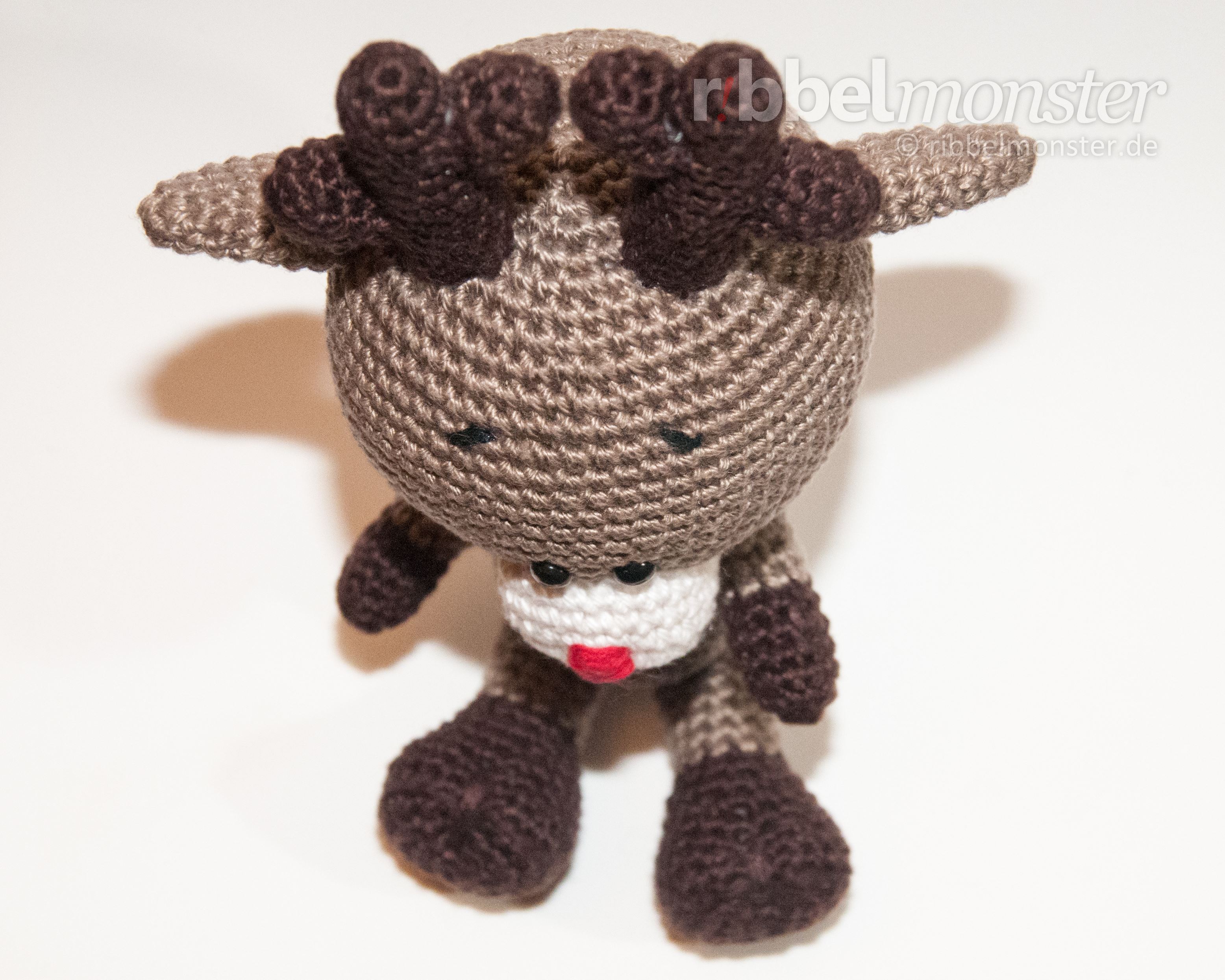

Content
Introduction: Amigurumi – Crochet Reindeer “Rudi”
To successfully crochet the Amigurumi Reindeer, it is essential to prepare in advance. Here you will find all necessary information about prerequisites, materials, and size. If you need help, you will find additional links in the respective sections.
Attention! Amigurumis are very cute and, therefore, not only popular among adults. Children often see them as toys, so you should be especially careful. Amigurumis that are not intended for play should be kept out of the reach of children. If an Amigurumi is meant to be played with by children, you should strictly adhere to the guidelines for toys. If you plan to give away or sell Amigurumis (license for sellers), you must strictly adhere to the legal requirements for toys and display the required CE marking.
Prerequisites
The successful implementation of this crochet pattern for an Amigurumi Reindeer assumes that you are familiar with the following crochet techniques. If this is not yet the case, you will find detailed tutorials here to learn them quickly.
- Crochet Magic Ring
- Decreases
- Increases
- Loops of a Stitch
- Single Crochet Stitches (US!)
- spiral rounds
Note! By offsetting regular increases and decreases, they become almost invisible. You can recognize regular increases by the phrase “double every … stitch,” and regular decreases by the phrase “crochet together every … and … stitch”. The stitch chart for spheres and circles might also be helpful for you.
Note! Using a special technique for invisible decreases makes them nearly invisible. Although this technique requires a bit of practice, it’s worth giving it a try.
Supplies
The Amigurumi Reindeer was crocheted with the following materials. The Amigurumi Reindeer can be crocheted with any yarn and the corresponding hook size. If you expect an identical result, you should try to use exactly the shown materials. In addition to the materials, you will also find a list of the necessary tools and supplies here.
Crochet Hook
You will need a crochet hook with a size of B or C (alphabetic) or 1 1/2 (numeric). For converting to other sizes, the crochet hook size converter will help you. I have selected some great crochet hooks for you here.
Darning Yarn
I have used darning yarn in the shade of black here. If you cannot find a suitable darning yarn in your supplies, I have already selected some for you.
Darning Yarn
Colour: red Help? View example
Filling
For filling, I used synthetic filling made of 100% polyester. However, there are numerous alternatives for filling material. If you’ve run out of filling, I’ve prepared a refill for you here.
Garn – Schachenmayr – Catania – dark brown
I used yarn in the shade Coffee. The material is 100% cotton. The yardage is 137 yds / 1.75 oz. If you want to replenish your supply, I’ve already picked out the matching yarn for you here.
Pins
You’ll also need a few pins. The more colorful your collection, the better. If you need more, I’ve found something for you.
Safety Eyes
I used 2 safety eyes with a diameter of 1/4 inches. The eyes are completely black. However, there are countless alternatives for amigurumi eyes. You might prefer other safety eyes as well.
Scissors
You’ll need any scissors. It’s best to use your most beautiful scissors because it brings you joy. If you don’t have really nice scissors, I’ve picked out some lovely ones for you.
Wool Needle
You’ll need a wool needle with a blunt tip. The thickness of the wool needle should match the thickness of your yarn. You might like the set of wool needles I’ve picked out for you.
Yarn – Schachenmayr – Catania – grey brown – 254
Colour: grey brown Size: 137yds / 1.75oz Material: 100% cotton Help? View example
Note! The specified yarn was used for the example shown here. In principle, you can use any yarn and an appropriate needle size. However, the quality of the material also affects the quality of the result, so you should avoid cutting corners in the wrong place. Also, the thickness of the yarn and the needle will influence the size of the outcome, which you can, of course, intentionally take advantage of.
Note! I have used safety eyes here. If you have never attached safety eyes before, you can also find detailed instructions on how to attach safety eyes here. In addition to a wide selection of other safety eyes, there are also numerous alternatives for amigurumi eyes. Simply use the eyes that you like best.
Size
Here are the size specifications for the crocheted Amigurumi Reindeer. The height was measured while standing without antlers. Please note that the actual size depends on the yarn used, the size of the crochet hook, and individual crochet tension.
| Needle Size | Yardage | Size |
|---|---|---|
| Crochet Hook B, C or 1 1/2 | 137 yds / 1.75 oz | 6 1/5 inch |
| Crochet Hook C, D or 2 1/2 | 120 yds / 1.75 oz | ? |
| Crochet Hook E or 4 | 93 yds / 1.75 oz | ? |
Note! If you want to change the size, you can simply use a thicker or thinner yarn with a suitable needle size. Simply doubling the rounds, rows, and stitches, on the other hand, will only result in an uneven outcome.
Crochet Pattern: Amigurumi – Crochet Reindeer “Rudi”
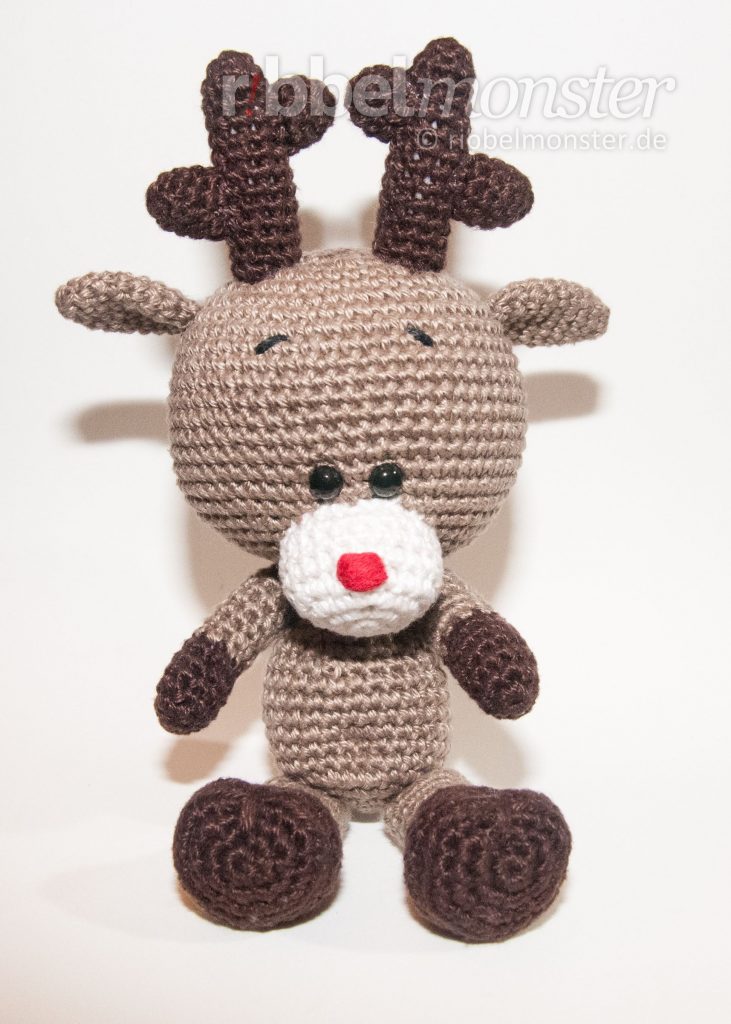
For the cheeky Amigurumi Crochet Reindeer, first, the head and body are created, followed by arms, legs, snout, tail, antlers, and ears. Afterward, all parts are sewn together, individual parts are shaped, and embroideries are applied.
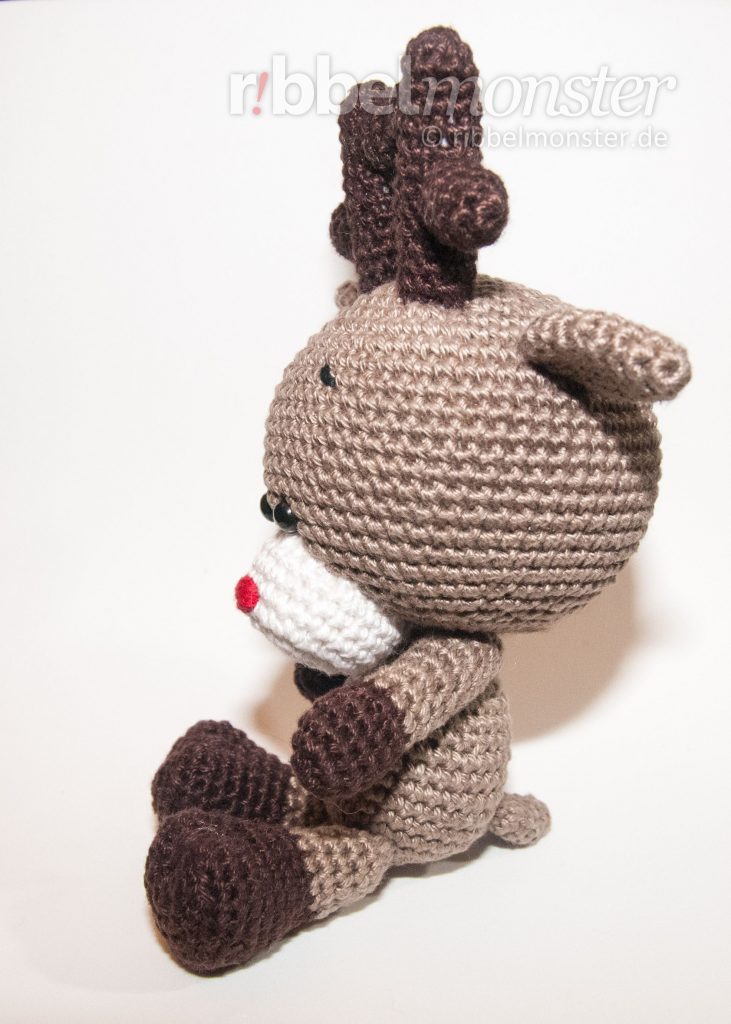
But even if this sounds very complicated now, it’s not too difficult. Just follow all descriptions and images! If you ever don’t know what to do next, you can always ask us through the comment function.
Head for Crochet Reindeer (1x)

The head for the Crochet Reindeer is crocheted from top to bottom in spiral rounds using only single crochet stitches (US!). The head is filled and stuffed neatly. The remaining thread end will be needed later to sew the head all around to a body.
Note! If you want to achieve a particularly beautiful result, you can hide regular increases and decreases by offsetting them a little. You can recognize regular increases by the phrase “double every … stitch,” and regular decreases by the phrase “crochet together every … and … stitch”. The stitch chart for spheres and circles might also be helpful for you. Additionally, you can apply a special crochet technique here for invisible decreases.
- gray-brown:
- 1st round:
- magic ring
- into the magic ring:
- 6 single crochet stitches (US!)
- = 6 stitches
- 2nd round:
- double every stitch
- = 12 stitches
- 3rd round:
- double every 2nd stitch
- = 18 stitches
- 4th round:
- double every 3rd stitch
- = 24 stitches
- 5th round:
- double every 4th stitch
- = 30 stitches
- 6th round:
- double every 5th stitch
- = 36 stitches
- 7th round:
- double every 6th stitch
- = 42 stitches
- 8th round:
- double every 7th stitch
- = 48 stitches
- 9th round:
- double every 8th stitch
- = 54 stitches
- 10th round:
- double every 9th stitch
- = 60 stitches
- 11th – 21st round:
- (= 11 rounds)
- every stitch one stitch
- = 60 stitches
- attach safety eyes, position:
- after the 19th round
- 2 stitches distance
- 22nd round:
- crochet together every 9th and 10th stitch
- = 54 stitches
- 23rd round:
- crochet together every 8th and 9th stitch
- = 48 stitches
- 24th round:
- crochet together every 7th and 8th stitch
- = 42 stitches
- 25th round:
- crochet together every 6th and 7th stitch
- = 36 stitches
- 26th round:
- crochet together every 5th and 6th stitch
- = 30 stitches
- 27th round:
- crochet together every 4th and 5th stitch
- = 24 stitches
- 28th round:
- crochet together every 3rd and 4th stitch
- = 18 stitches
- fill and stuff completely
- 29th round:
- crochet together every 2nd and 3rd stitch
- = 12 stitches
- cut yarn generously, pull through loop, do NOT cut the yarn end, it will be used later for sewing
Body for Crochet Reindeer (1x)
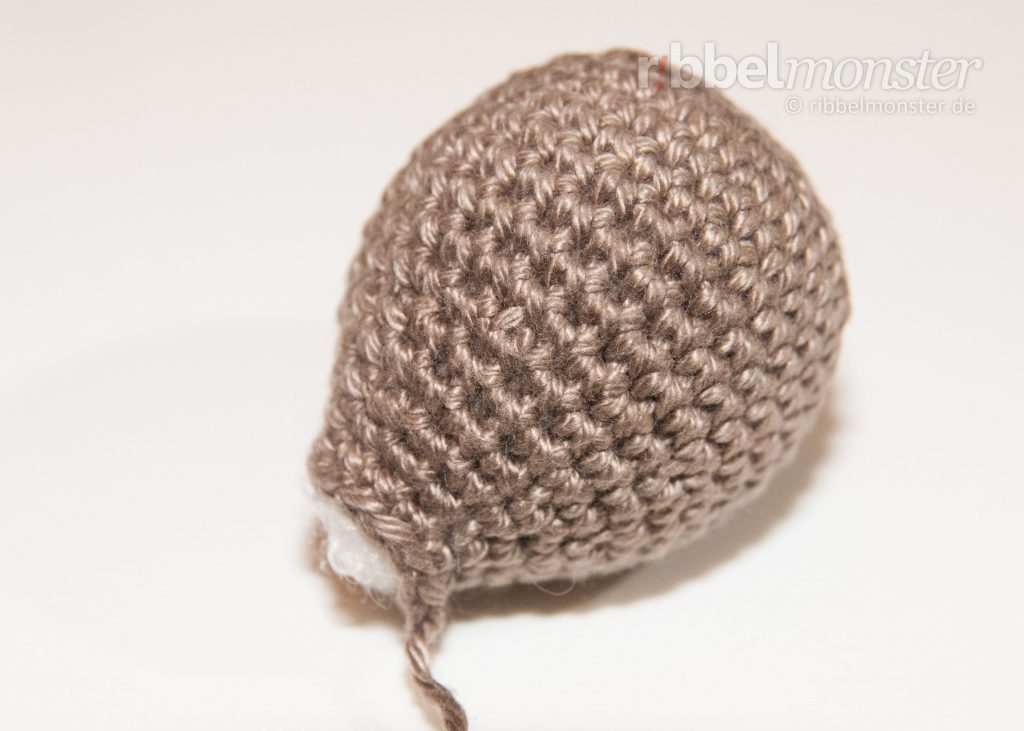
The body for the Crochet Reindeer is crocheted from bottom to top using only single crochet stitches (US!) in spiral rounds. Head and body are later sewn together with the openings facing each other.
Note! If you want to achieve a particularly beautiful result, you can hide regular increases and decreases by offsetting them a little. You can recognize regular increases by the phrase “double every … stitch,” and regular decreases by the phrase “crochet together every … and … stitch”. The stitch chart for spheres and circles might also be helpful for you. Additionally, you can apply a special crochet technique here for invisible decreases.
- gray-brown:
- 1st round:
- magic ring
- into the magic ring:
- 6 single crochet stitches (US!)
- = 6 stitches
- 2nd round:
- double every stitch
- = 12 stitches
- 3rd round:
- double every 2nd stitch
- = 18 stitches
- 4th round:
- double every 3rd stitch
- = 24 stitches
- 5th round:
- double every 4th stitch
- = 30 stitches
- 6th – 11th round:
- (= 6 rounds)
- every stitch one stitch
- = 30 stitches
- 12th round:
- crochet together every 9th and 10th stitch
- = 27 stitches
- 13th round:
- crochet together every 8th and 9th stitch
- = 24 stitches
- 14th round:
- crochet together every 7th and 8th stitch
- = 21 stitches
- 15th round:
- crochet together every 6th and 7th stitch
- = 18 stitches
- 16th round:
- crochet together every 5th and 6th stitch
- = 15 stitches
- 17th round:
- crochet together every 4th and 5th stitch
- = 12 stitches
- 18th round:
- every stitch one stitch
- = 12 stitches
- cut the thread, pull off the loop
Ears for Crochet Reindeer (2x)
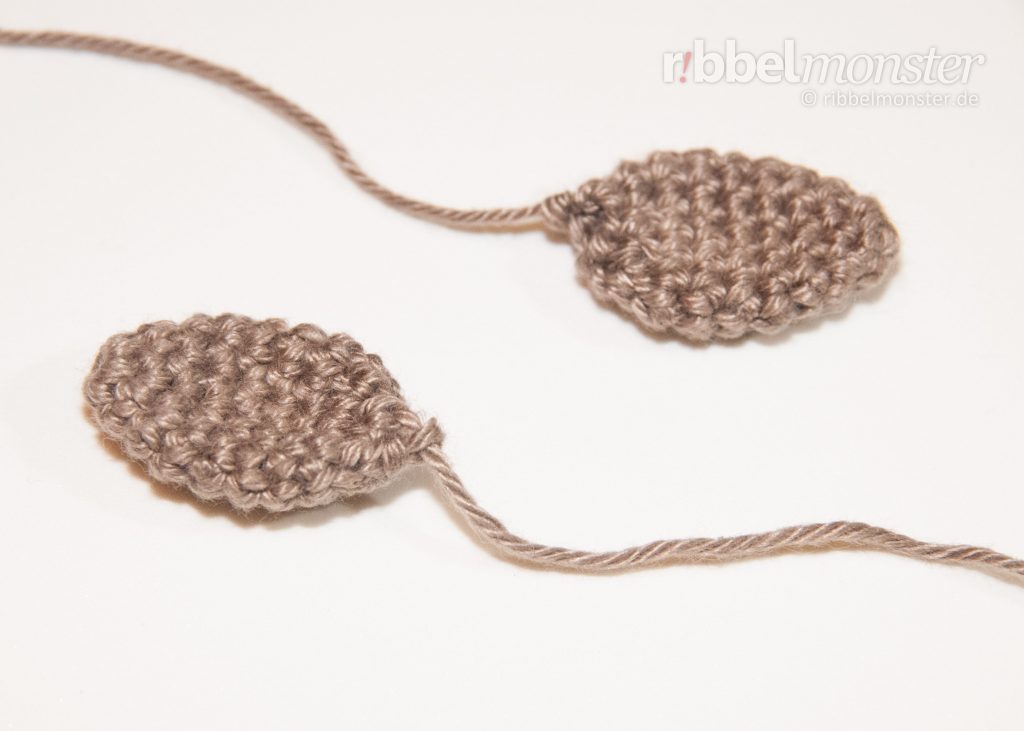
Next, let’s make the ears for the Crochet Reindeer. We also crochet the ears from top to bottom in spiral rounds. However, the ears are not filled so that they can later be sewn flat with the thread end to the head.
Note! If you want to create several nearly identical parts, it’s advisable to work on them consecutively on the same day. For larger parts, it’s even recommended to work on them simultaneously in stages. Our tension and tightness can vary from day to day, leading to visible differences.
Note! If you want to achieve a particularly beautiful result, you can hide regular increases and decreases by offsetting them a little. You can recognize regular increases by the phrase “double every … stitch,” and regular decreases by the phrase “crochet together every … and … stitch”. The stitch chart for spheres and circles might also be helpful for you. Additionally, you can apply a special crochet technique here for invisible decreases.
- gray-brown:
- 1st round:
- magic ring
- into the magic ring:
- 6 single crochet stitches (US!)
- = 6 stitches
- 2nd round:
- double every 3rd stitch
- = 8 stitches
- 3rd round:
- double every 4th stitch
- = 10 stitches
- 4th round:
- double every 5th stitch
- = 12 stitches
- 7th – 14th round:
- (= 4 rounds)
- every stitch one stitch
- = 12 stitches
- 9th round:
- crochet together every 1st and 2nd stitch
- = 6 stitches
- cut yarn generously, pull through loop, do NOT cut the yarn end, it will be used later for sewing
Snout for Crochet Reindeer (1x)
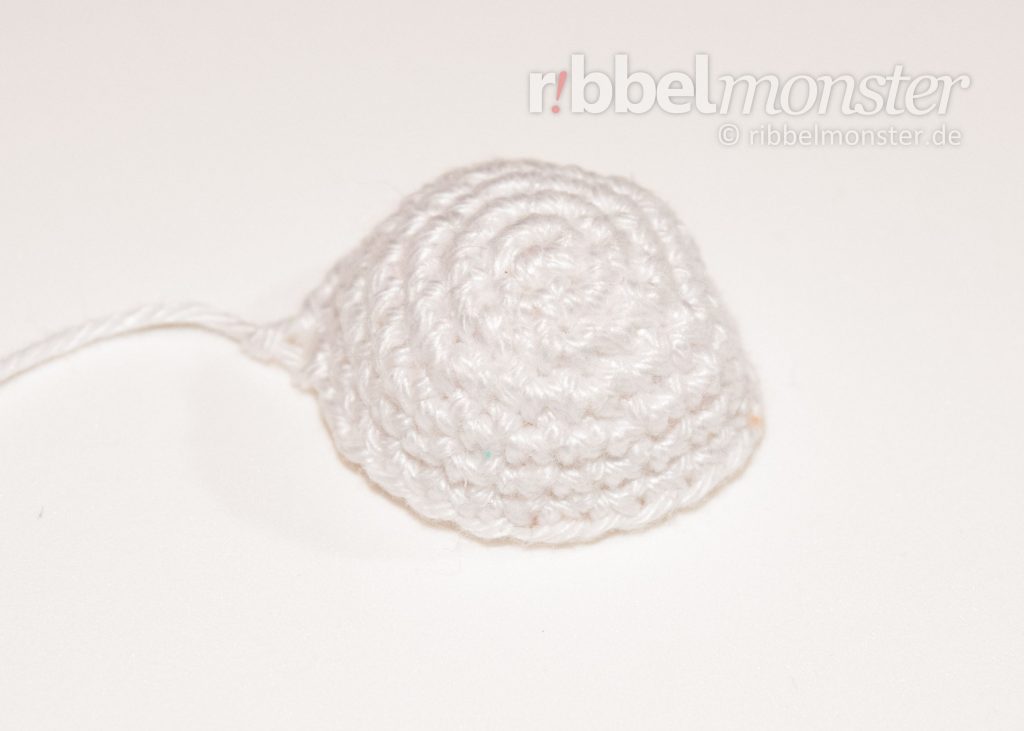
The snout for the Crochet Reindeer is crocheted from the inside to the outside in spiral rounds using only single crochet stitches (US!). The snout is later sewn around the head with the thread end and filled at that time.
Tip: Wenn du ein besonders schönes Ergebnis erhalten möchtest, kannst du die regelmäßigen Zunahmen durch Versetzen ein wenig verstecken. Dazu verwendest du einfach die Maschentabelle für Kugeln und Kreise.
(Redaktion: Block ersetzen)
- white:
- 1st round:
- magic ring
- into the magic ring:
- 6 single crochet stitches (US!)
- = 6 stitches
- 2nd round:
- double every stitch
- = 12 stitches
- 3rd round:
- double every 2nd stitch
- = 18 stitches
- 4th round:
- double every 3rd stitch
- = 24 stitches
- 5th – 7th round:
- (= 3 rounds)
- every stitch one stitch
- = 24 stitches
- cut yarn generously, pull through loop, do NOT cut the yarn end, it will be used later for sewing
Tail for Crochet Reindeer (1x)
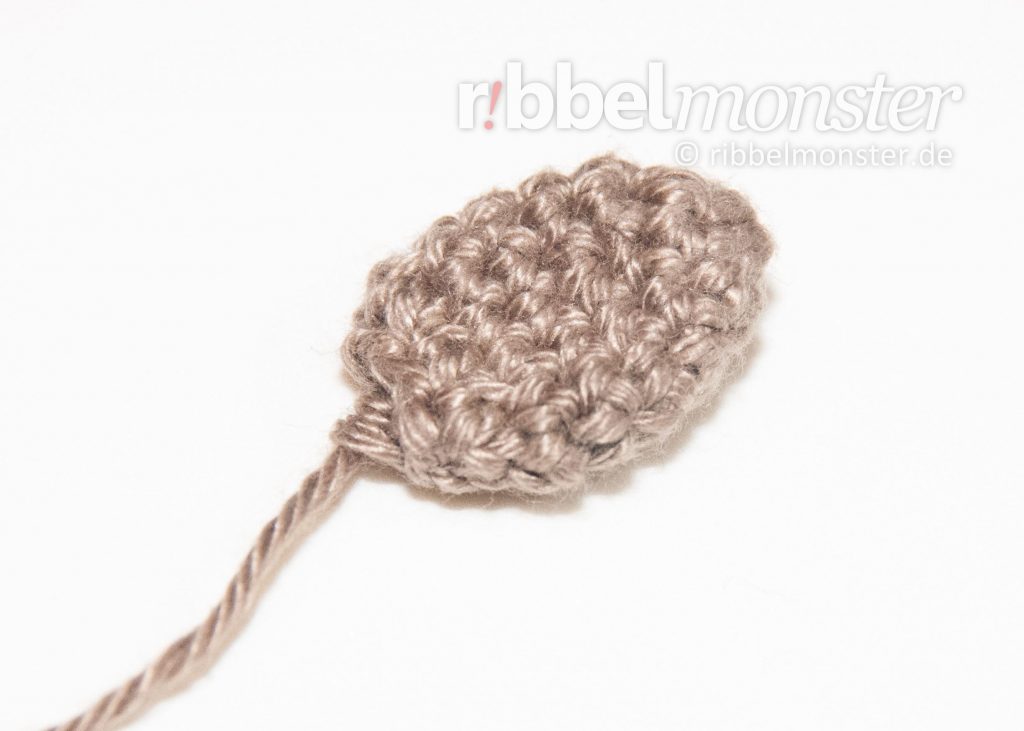
The tail for the Crochet Reindeer is crocheted from the tip to the base in spiral rounds using only single crochet stitches (US!). The tail is not filled but folded flat and later sewn to the back with the remaining thread end.
Note! If you want to achieve a particularly beautiful result, you can hide regular increases and decreases by offsetting them a little. You can recognize regular increases by the phrase “double every … stitch,” and regular decreases by the phrase “crochet together every … and … stitch”. The stitch chart for spheres and circles might also be helpful for you. Additionally, you can apply a special crochet technique here for invisible decreases.
- gray-brown:
- 1st round:
- magic ring
- into the magic ring:
- 6 single crochet stitches (US!)
- = 6 stitches
- 2nd round:
- double every 3rd stitch
- = 8 stitches
- 3rd round:
- double every 4th stitch
- = 10 stitches
- 4th round:
- double every 5th stitch
- = 12 stitches
- 5th + 6th round:
- (= 2 rounds)
- every stitch one stitch
- = 12 stitches
- 7th round:
- crochet together every 1st and 2nd stitch
- = 6 stitches
- cut yarn generously, pull through loop, do NOT cut the yarn end, it will be used later for sewing
Arms for Crochet Reindeer (2x)
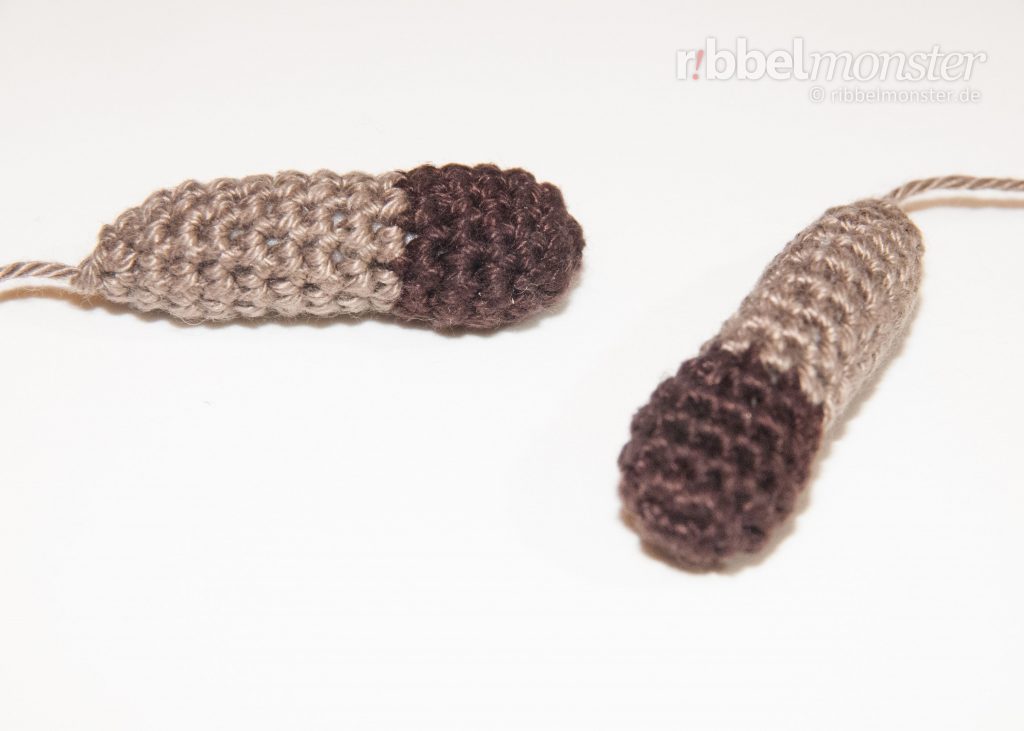
The arms for the Crochet Reindeer are crocheted from fingertips to shoulders in spiral rounds using only single crochet stitches (US!). Less filling is added to the front part to create flat palms.
Note! If you want to create several nearly identical parts, it’s advisable to work on them consecutively on the same day. For larger parts, it’s even recommended to work on them simultaneously in stages. Our tension and tightness can vary from day to day, leading to visible differences.
Note! If you want to achieve a particularly beautiful result, you can hide regular increases and decreases by offsetting them a little. You can recognize regular increases by the phrase “double every … stitch,” and regular decreases by the phrase “crochet together every … and … stitch”. The stitch chart for spheres and circles might also be helpful for you. Additionally, you can apply a special crochet technique here for invisible decreases.
- dark brown:
- 1st round:
- magic ring
- into the magic ring:
- 6 single crochet stitches (US!)
- = 6 stitches
- 2nd round:
- double every stitch
- = 12 stitches
- 3rd – 5th round:
- (= 3 rounds)
- every stitch one stitch
- = 12 stitches
- 6th round:
- crochet together every 3rd and 4th stitch
- = 9 stitches
- gray-brown:
- 7th – 14th round:
- (= 8 rounds)
- every stitch one stitch
- = 9 stitches
- fill and stuff completely
- 15th round:
- crochet together every 2nd and 3rd stitch
- = 6 stitches
- cut yarn generously, pull through loop, do NOT cut the yarn end, it will be used later for sewing
Legs for Crochet Reindeer (2x)
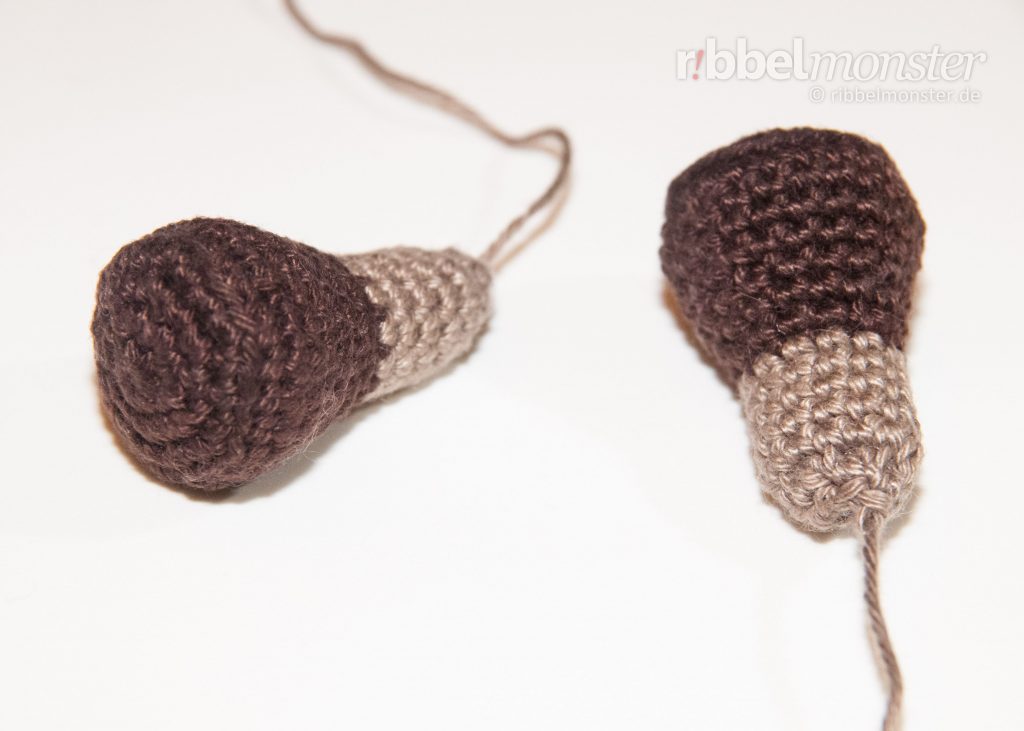
The legs for the Crochet Reindeer are crocheted from toes to hips in spiral rounds using only single crochet stitches (US!). The feet are filled properly, while the legs remain a bit looser for easy movement later.
Note! If you want to create several nearly identical parts, it’s advisable to work on them consecutively on the same day. For larger parts, it’s even recommended to work on them simultaneously in stages. Our tension and tightness can vary from day to day, leading to visible differences.
Note! If you want to achieve a particularly beautiful result, you can hide regular increases and decreases by offsetting them a little. You can recognize regular increases by the phrase “double every … stitch,” and regular decreases by the phrase “crochet together every … and … stitch”. The stitch chart for spheres and circles might also be helpful for you. Additionally, you can apply a special crochet technique here for invisible decreases.
- dark brown:
- 1st round:
- magic ring
- into the magic ring:
- 6 single crochet stitches (US!)
- = 6 stitches
- 2nd round:
- double every stitch
- = 12 stitches
- 3rd round:
- double every 2nd stitch
- = 18 stitches
- 4th round:
- double every 3rd stitch
- = 24 stitches
- 5th round:
- into the back loop only:
- every stitch one stitch
- = 24 stitches
- into the back loop only:
- 6th round:
- crochet together every 11th and 12th stitch
- = 22 stitches
- 7th round:
- crochet together every 10th and 11th stitch
- = 20 stitches
- 8th round:
- crochet together every 9th and 10th stitch
- = 18 stitches
- 9th round:
- crochet together every 8th and 9th stitch
- = 16 stitches
- 10th round:
- crochet together every 7th and 8th stitch
- = 14 stitches
- 11th round:
- crochet together every 6th and 7th stitch
- = 12 stitches
- gray-brown:
- 12th – 16th round:
- (= 5 rounds)
- every stitch one stitch
- = 12 stitches
- fill and stuff completely
- 17th round:
- crochet together every 1st and 2nd stitch
- = 6 stitches
- cut yarn generously, pull through loop, do NOT cut the yarn end, it will be used later for sewing
Antlers for Crochet Reindeer (0x)
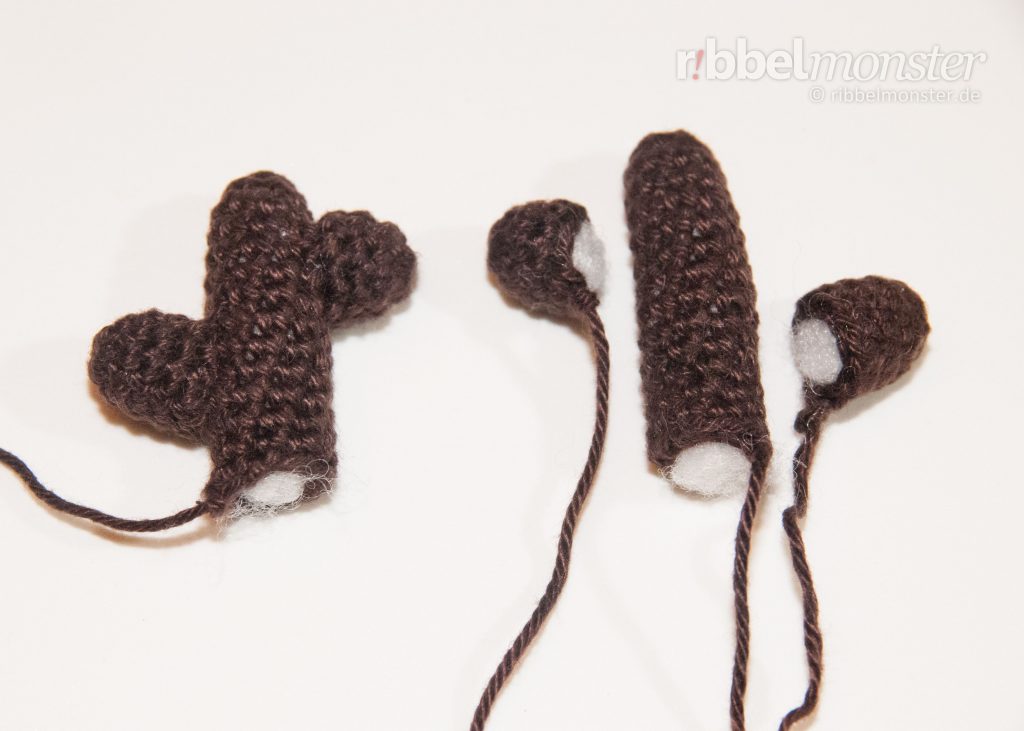
The reindeer’s antlers consist of 2 horns, each made up of a small, a medium, and a large part. All parts are crocheted from top to bottom in spiral rounds using only single crochet stitches (US!). Then all parts are filled and sewn together, creating two identical horns for the antlers.
Note! If you want to create several nearly identical parts, it’s advisable to work on them consecutively on the same day. For larger parts, it’s even recommended to work on them simultaneously in stages. Our tension and tightness can vary from day to day, leading to visible differences.
Small Part (2x)
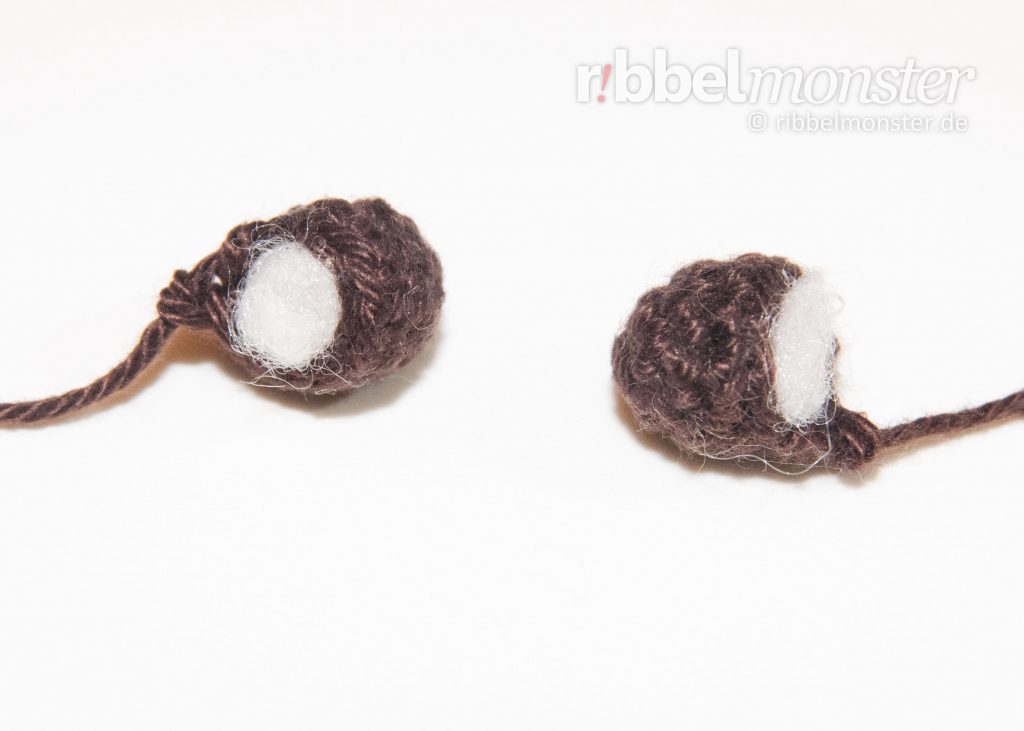
Tip: Wenn du ein besonders schönes Ergebnis erhalten möchtest, kannst du die regelmäßigen Zunahmen durch Versetzen ein wenig verstecken. Dazu verwendest du einfach die Maschentabelle für Kugeln und Kreise.
(Redaktion: Block ersetzen)
Note! If you want to create several nearly identical parts, it’s advisable to work on them consecutively on the same day. For larger parts, it’s even recommended to work on them simultaneously in stages. Our tension and tightness can vary from day to day, leading to visible differences.
- dark brown:
- 1st round:
- magic ring
- into the magic ring:
- 6 single crochet stitches (US!)
- = 6 stitches
- 2nd round:
- double every 2nd stitch
- = 9 stitches
- 3rd + 4th round:
- (= 2 rounds)
- every stitch one stitch
- = 9 stitches
- cut yarn generously, pull through loop, do NOT cut the yarn end, it will be used later for sewing
Medium Part (2x)
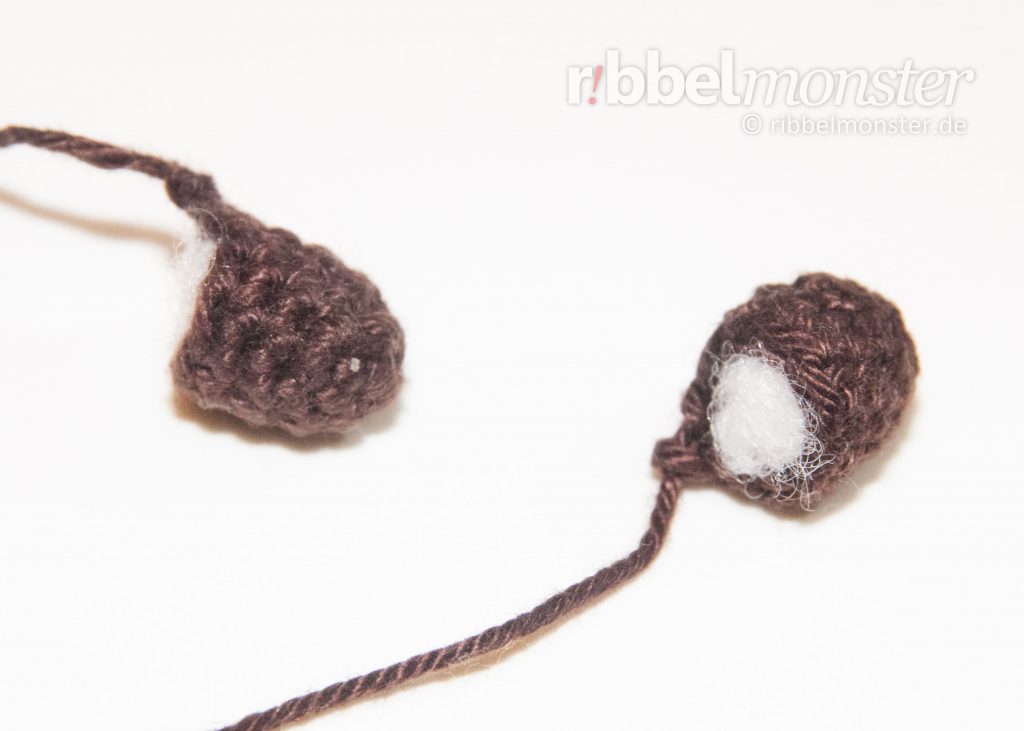
Tip: Wenn du ein besonders schönes Ergebnis erhalten möchtest, kannst du die regelmäßigen Zunahmen durch Versetzen ein wenig verstecken. Dazu verwendest du einfach die Maschentabelle für Kugeln und Kreise.
(Redaktion: Block ersetzen)
Note! If you want to create several nearly identical parts, it’s advisable to work on them consecutively on the same day. For larger parts, it’s even recommended to work on them simultaneously in stages. Our tension and tightness can vary from day to day, leading to visible differences.
- dark brown:
- 1st round:
- magic ring
- into the magic ring:
- 6 single crochet stitches (US!)
- = 6 stitches
- 2nd round:
- double every 2nd stitch
- = 9 stitches
- 3rd – 5th round:
- (= 3 rounds)
- every stitch one stitch
- = 9 stitches
- cut yarn generously, pull through loop, do NOT cut the yarn end, it will be used later for sewing
Large Part (2x)
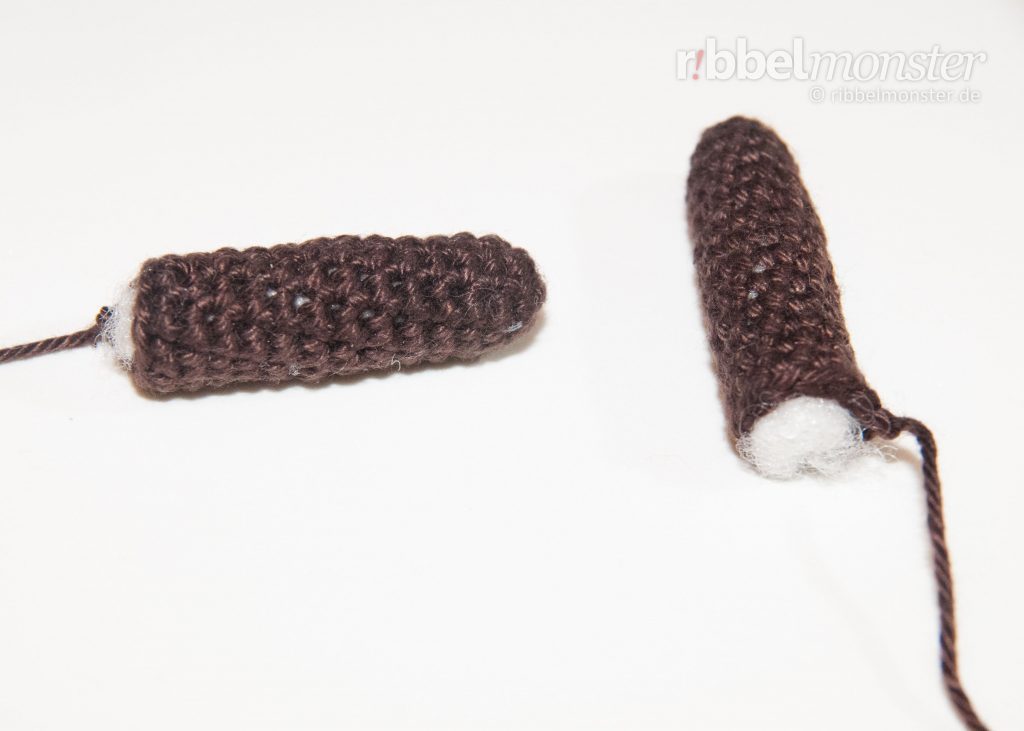
Tip: Wenn du ein besonders schönes Ergebnis erhalten möchtest, kannst du die regelmäßigen Zunahmen durch Versetzen ein wenig verstecken. Dazu verwendest du einfach die Maschentabelle für Kugeln und Kreise.
(Redaktion: Block ersetzen)
Note! If you want to create several nearly identical parts, it’s advisable to work on them consecutively on the same day. For larger parts, it’s even recommended to work on them simultaneously in stages. Our tension and tightness can vary from day to day, leading to visible differences.
- dark brown:
- 1st round:
- magic ring
- into the magic ring:
- 6 single crochet stitches (US!)
- = 6 stitches
- 2nd round:
- double every 2nd stitch
- = 9 stitches
- 3rd – 14th Round:
- (= 12 rounds)
- every stitch one stitch
- = 9 stitches
- cut yarn generously, pull through loop, do NOT cut the yarn end, it will be used later for sewing
Assemble Antlers (2x)

You should now have 6 individual parts, 2 of each kind. Now you can fill and stuff all parts well. Then, sew one small and one medium part with the opening to a large part. The small part sits on one side at the top, and the medium part sits on the other side at the bottom. You can simply follow the photo to attach the parts. For sewing the parts, you can use the remaining thread ends.
Finish Reindeer

After crocheting all parts, the puzzle can be completed. Before you start, make sure to pin the crocheted reindeer together with pins to find the right positions. This makes sewing it together easier, and you can easily make corrections.
Sew Head to Body
First, sew the head and body together with the openings facing each other. Use the long thread end from the head and work around the two openings. If you’ve never done this before, the pattern for sewing together open parts might be helpful.

Attach Snout to Head
Now you can sew the snout onto the head with the remaining yarn end. It is very helpful to first pin it in place with needles and gradually remove them as you go around. Just before completing the round, fill and stuff the snout well.
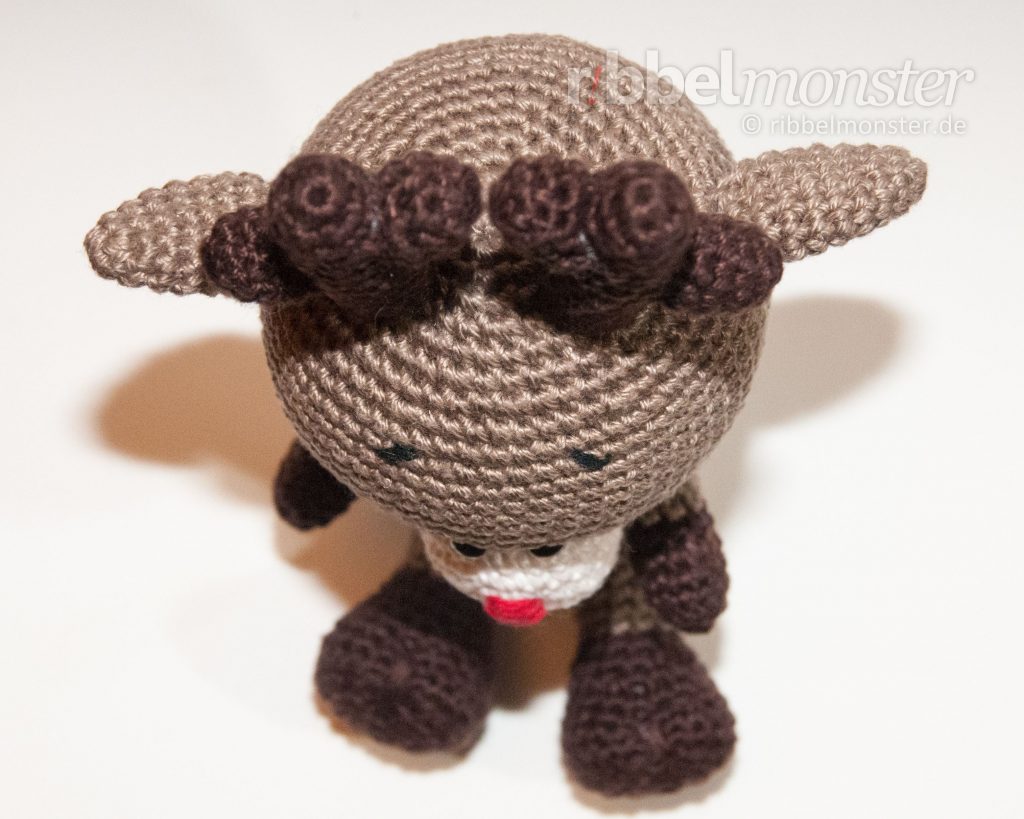
Sew Ears to Head
Next, you can sew the ears onto the head. They are not filled, only folded flat. The open side sits horizontally on the 10th round on the side of the head. Both ears form a line parallel to the eyes when viewed from above.
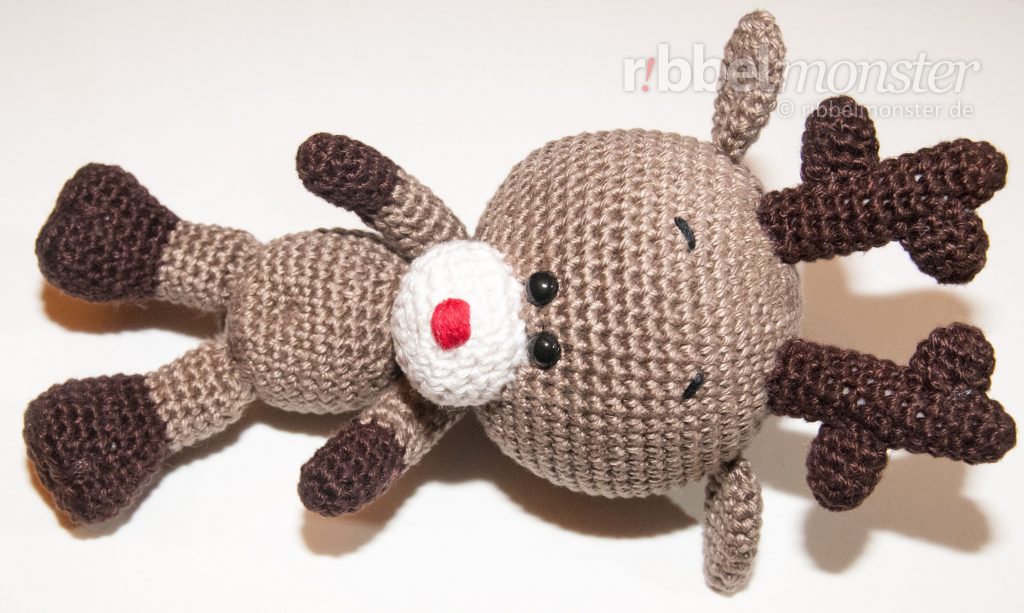
Attach Arms and Legs
Next, you can sew the arms just below the head. Either fold them flat horizontally or make them movable with thread joints, as described in the [link to joint pattern](/?p=5369). The legs are sewn horizontally, folded in the middle, in a line to the center of the underside.
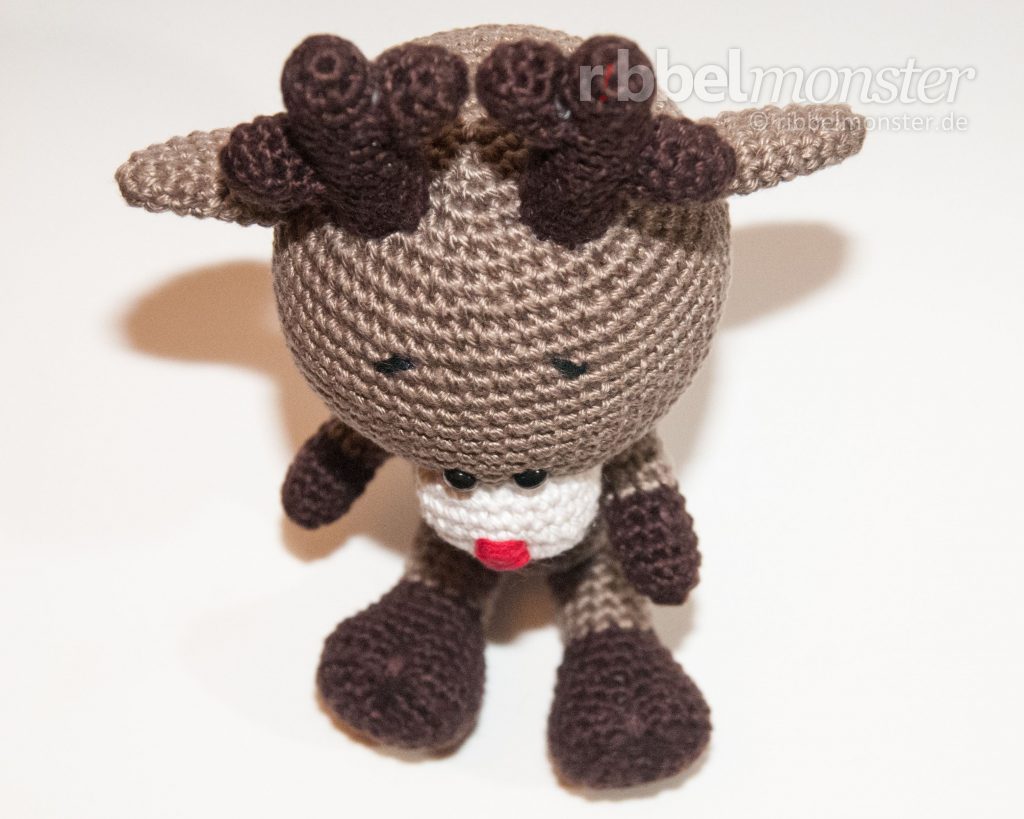
Attach Antlers to Head
Next, you can tackle the antlers. They sit on the head in a line parallel to the eyes, between the ears but slightly offset from the center towards the face. Ensure that the branches of the antlers are symmetrically arranged. Sew the filled antlers with the remaining yarn end around the head with the open side to make them stand upright.
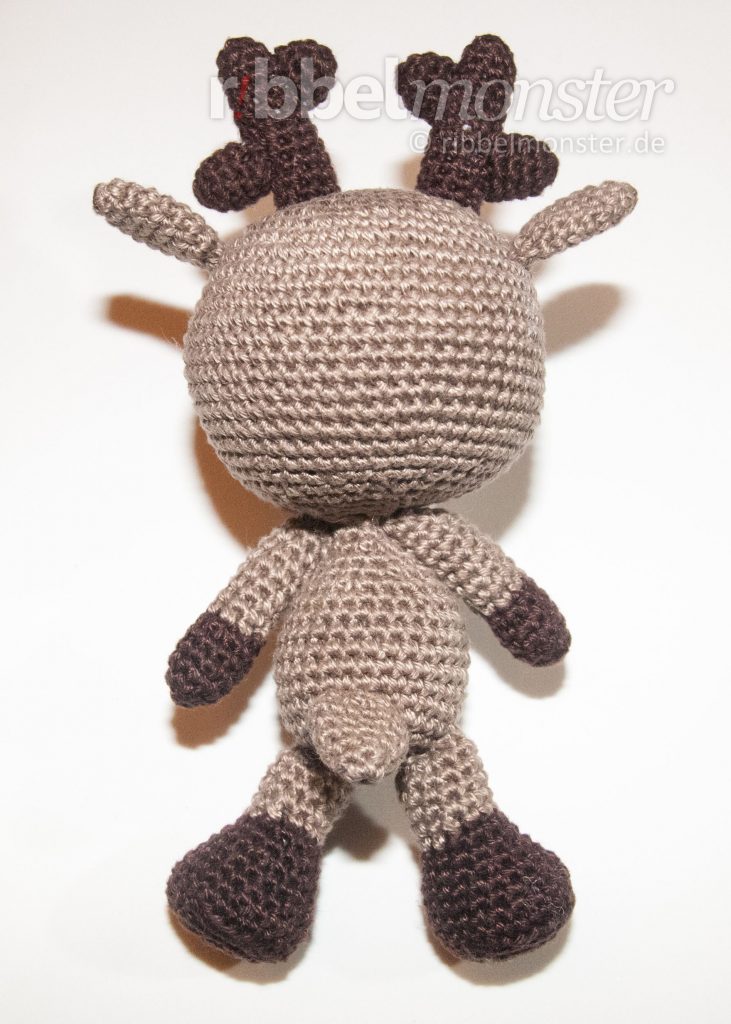
Sew Tail to Body
Now, sew the tail in the middle on the back. Fold the open end flat and sew it horizontally around the 6th round. The reindeer’s tail acts as a counterbalance for it to sit, so this placement should be well considered.

Embroider Eyebrows
Finally, embroider the eyebrows with black embroidery thread or yarn. They sit 7th and 8th rounds above the eyes, slanting inwards and upwards.
Embroider a Nose
Embroider the nose with red embroidery thread or yarn in the center just above the snout. Make horizontal stitches over two stitches until the nose has the desired volume.

Shape Belly Button
Next, pull the belly button inward with yarn of matching color. Insert the needle horizontally around two stitches in the front at the appropriate spot and pull it out on the back around two stitches below the tail.
Shape Claws
Afterward, tie off both feet in the front center to create the two typical claws on each foot.
Done!
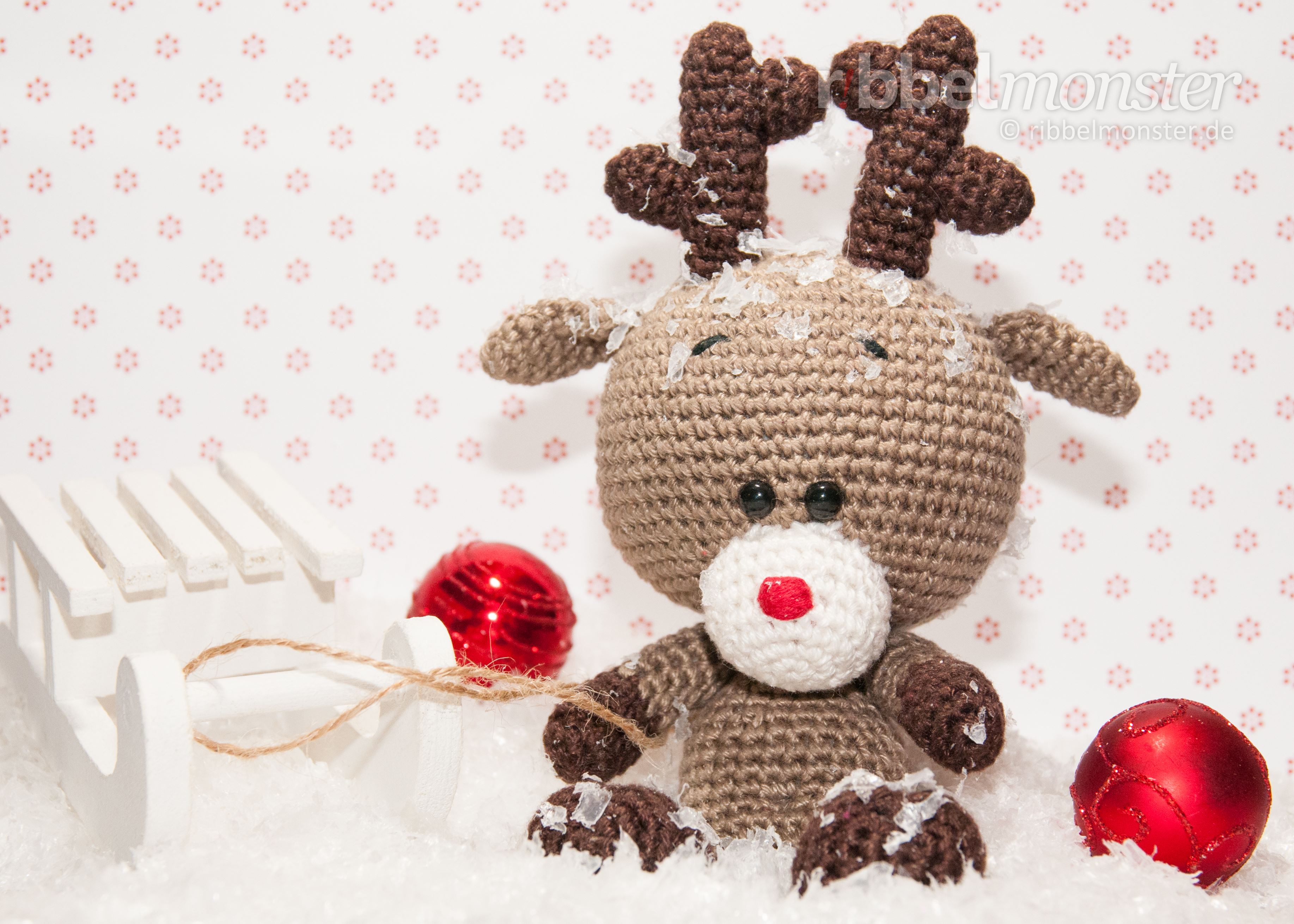
Your crocheted reindeer is now complete! It naturally fits well into the festive Christmas season. If you’re still looking for a bit of activity for the holidays, I’ve picked something out for you here.
Vielleicht hast du aber auch Lust die anderen Amigurumis der Naminja Serie nachzuarbeiten.
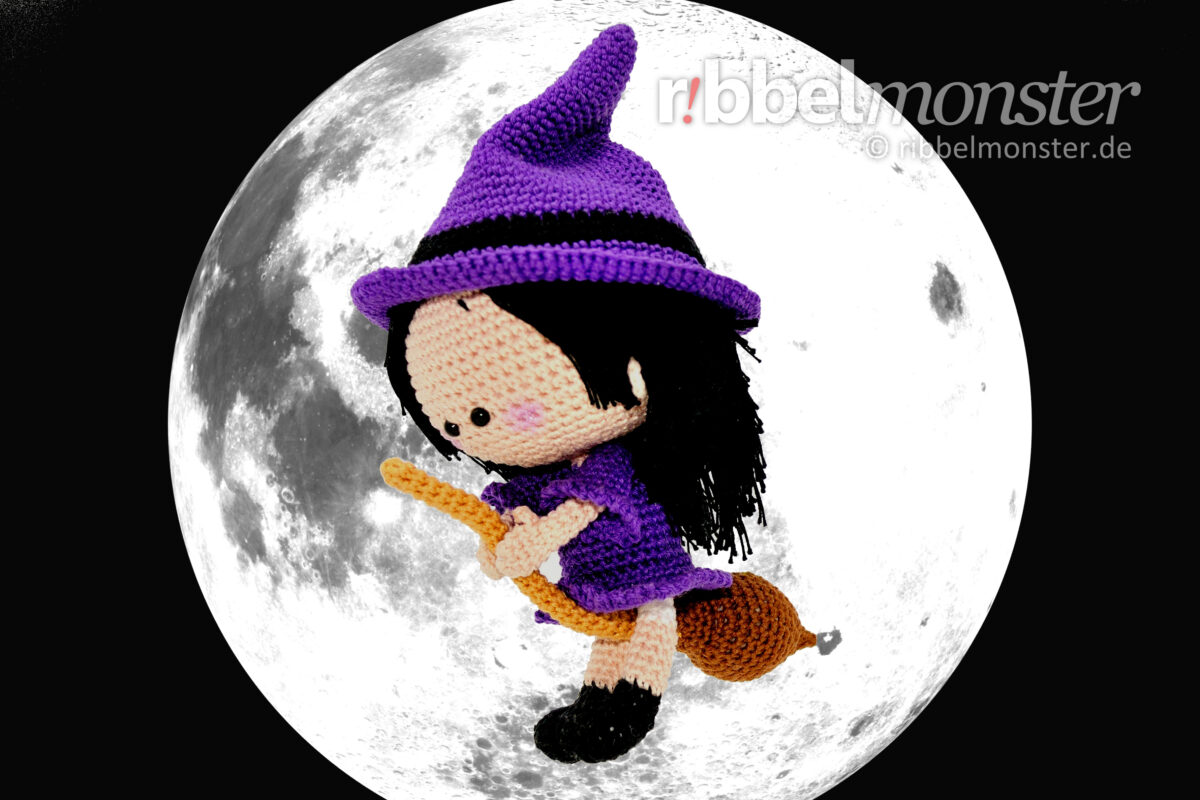
Schau mal wer gerda am Mond vorbei geflogen ist. Das ist die kleine Hexe Mechthild auf ihrem neuen Hexenbesen.
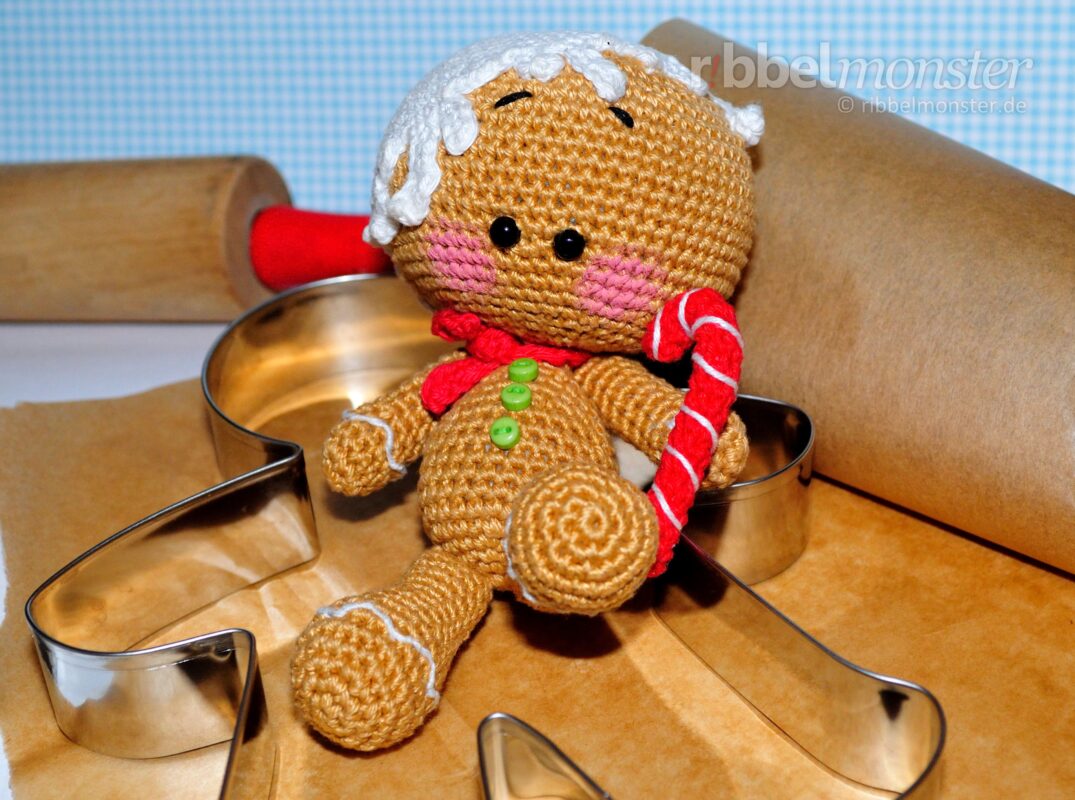
Wenn du Lust hast, können wir zusammen den zuckersüßen Lebkuchenmann Pepe häkeln.
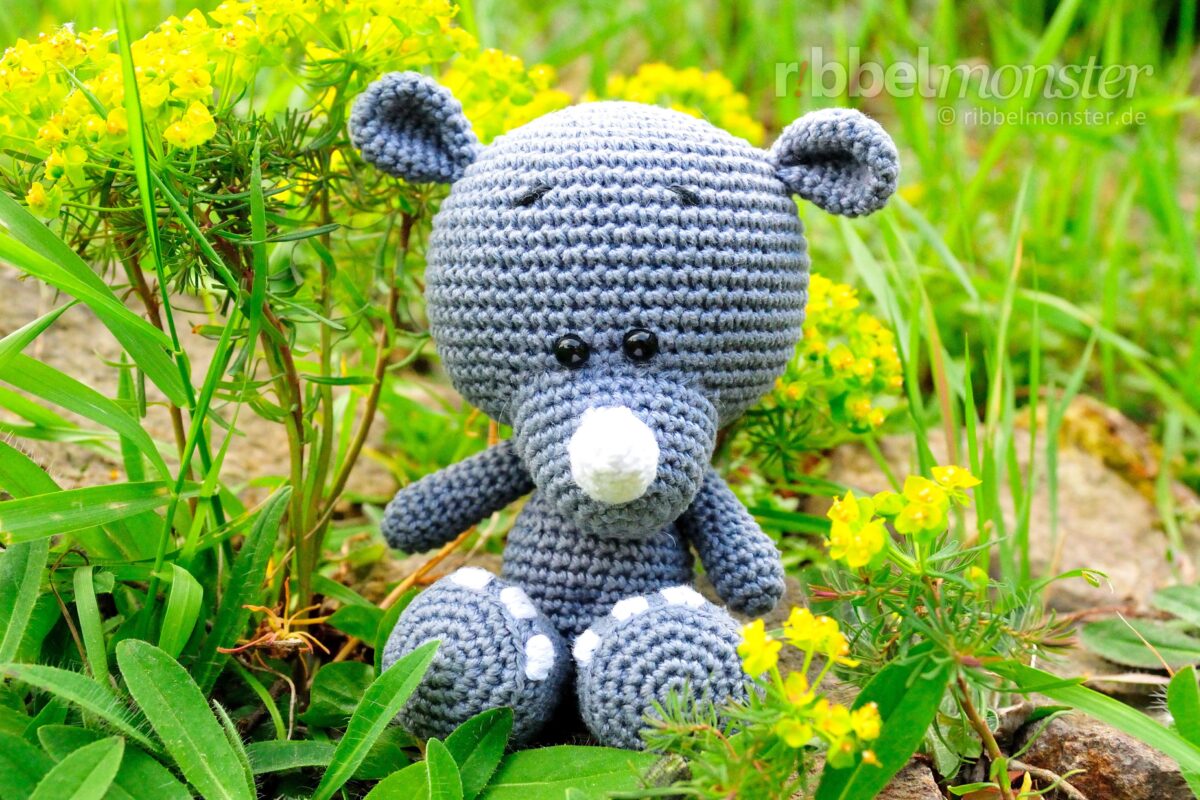
Am liebsten Mag das Nashorn Piko sonniges Wetter und saftige Wiesen.
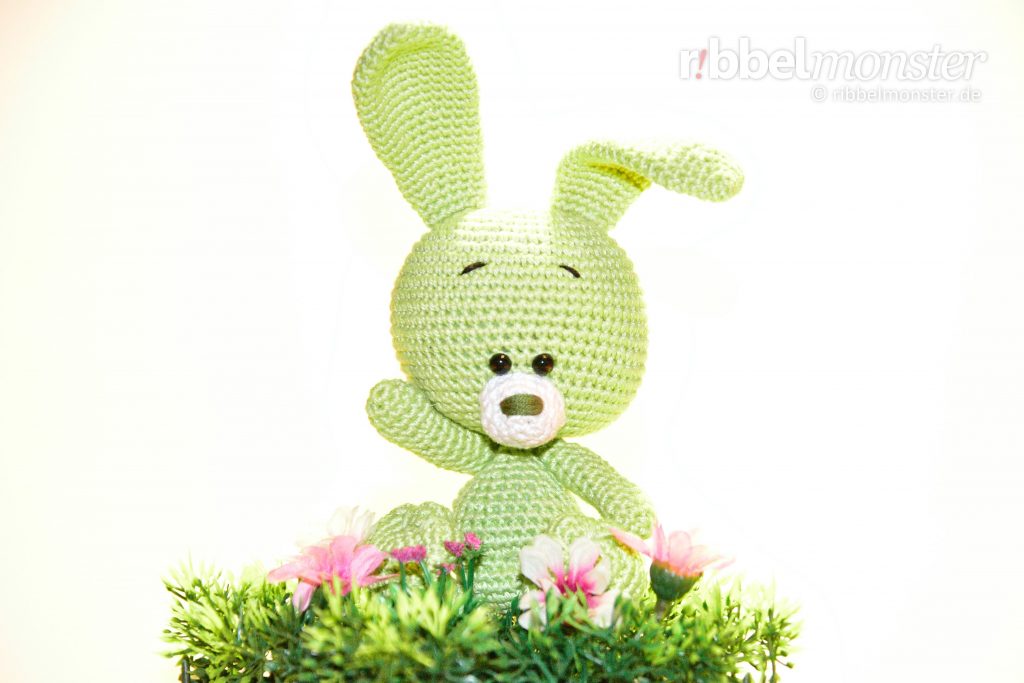
Schau mal wer da so eifrig winkt. Da sitzt doch Hase Ono mitten in der Blumenwiese.
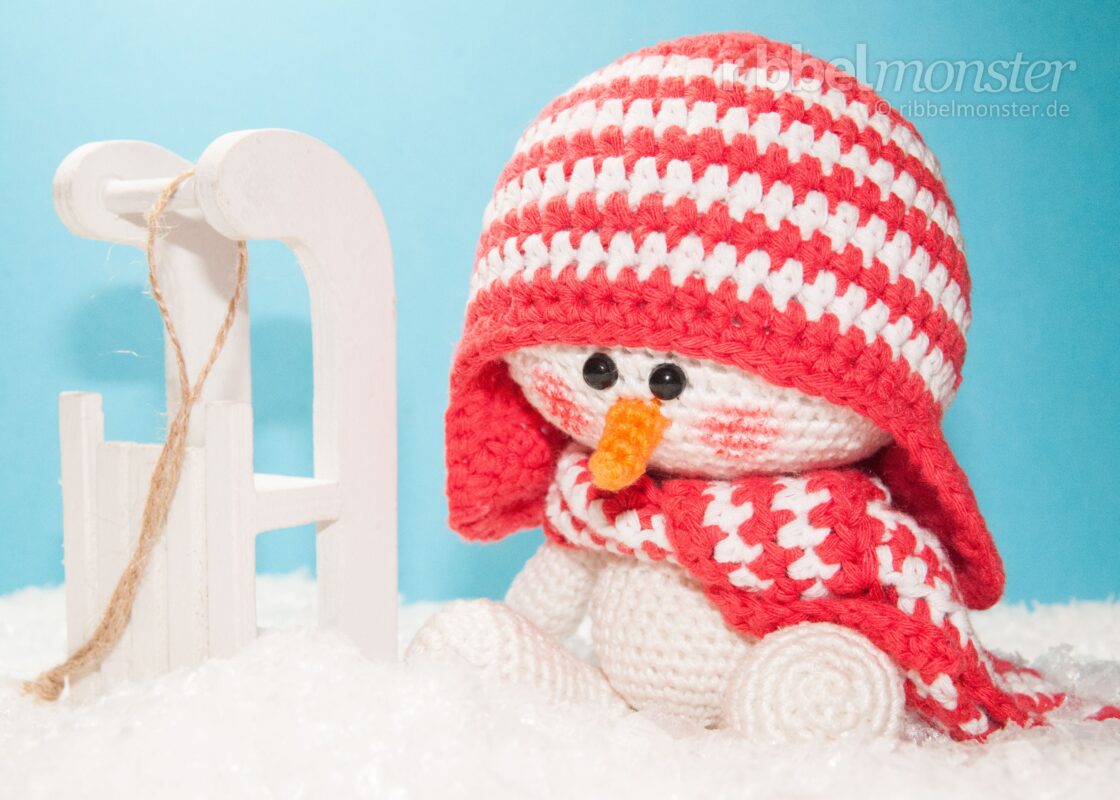
Der kleine Schneemann Sven sitzt schon den ganzen Tag mit seinem Schlitten am Fenster und wartet auf den ersten Schnee.
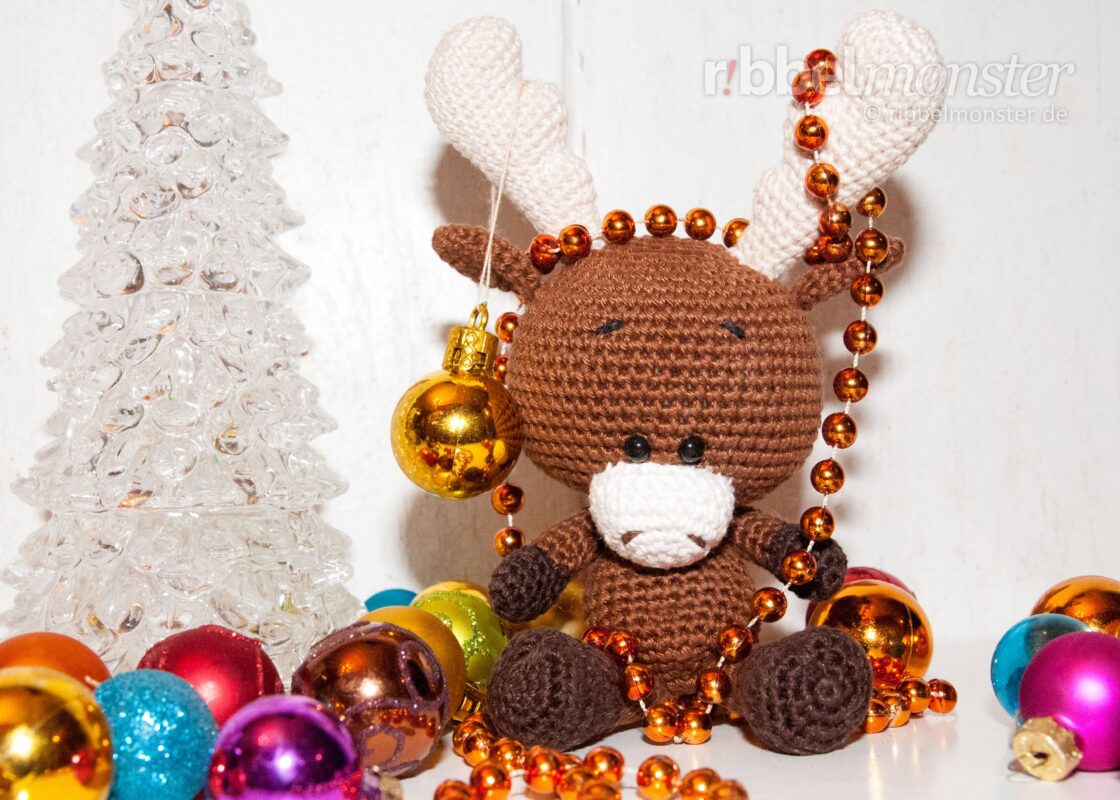
Ich fürchte unser Elch Sören hat sich schon wieder im Christbaumschmuck verheddert. Kannst du ihn retten?
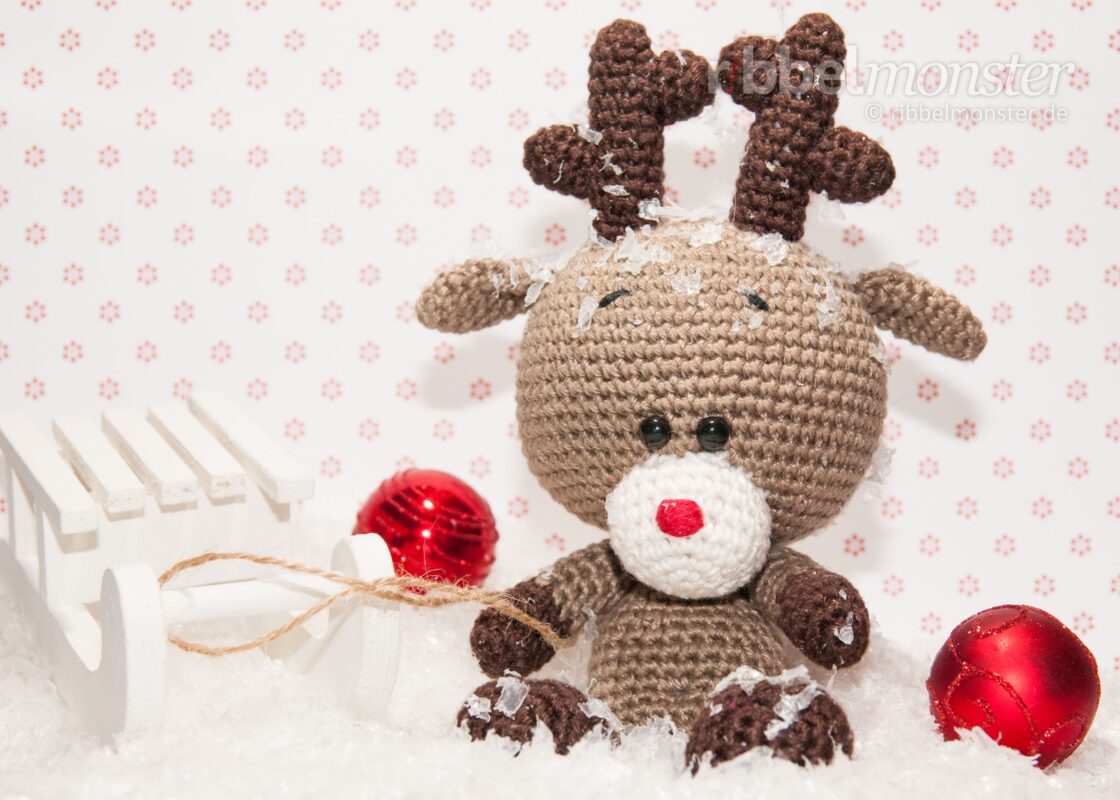
Es sieht ganz so aus, als hätte das Rentier Rudi schon den Schlitten bereit gemacht.
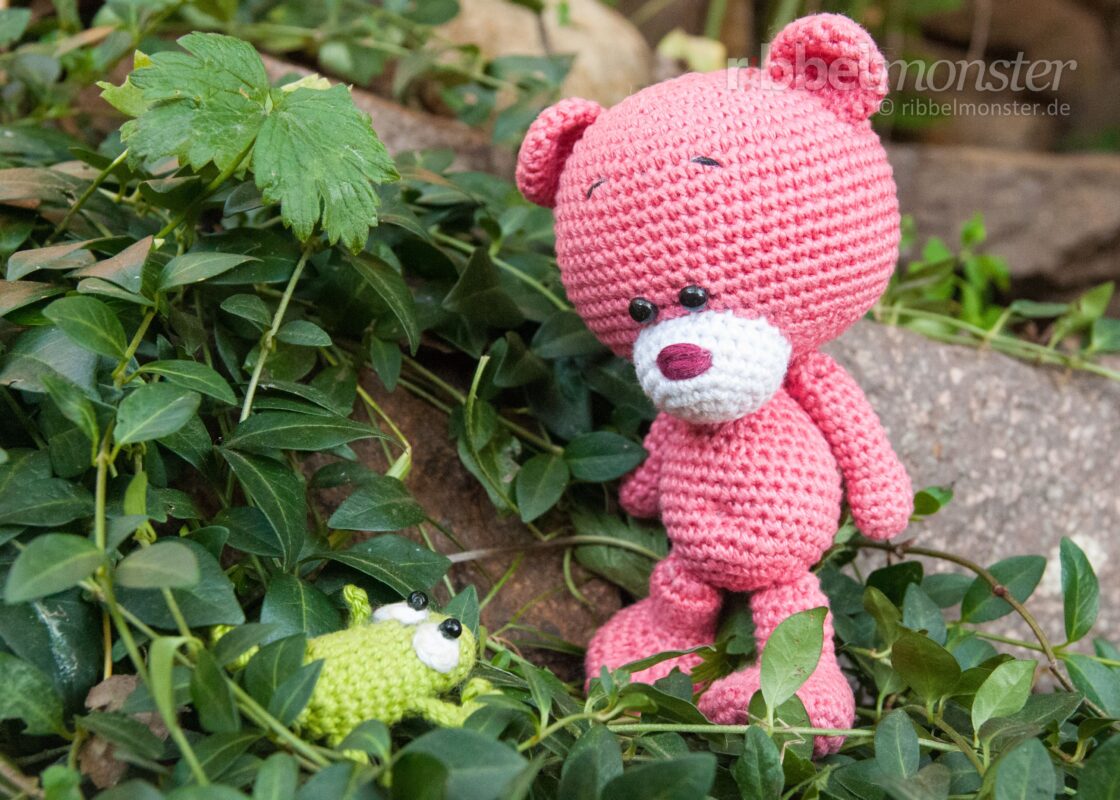
Ich glaube Teddy Pina hat sich gerade fürchterlich erschreckt. Weißt du was das ist?
